Global Private Equity Report

At a Glance
- Private equity continued to reel in 2023 as rapidly rising interest rates led to sharp declines in dealmaking, exits, and fund-raising.
- The exit conundrum has emerged as the most pressing problem, as LPs starved for distributions pull back new allocations from all but the largest, most reliable funds.
- The long-term outlook remains sound, but breaking the logjam will require more robust approaches to value creation and rapid innovation in liquidity solutions.
This article is part of Bain’s 2024 Global Private Equity Report
It’s safe to say the private equity industry has never seen anything quite like what’s happened over the last 24 months.
While the sharp drop-off in deal activity in late 2022 and into 2023 echoes the period following the 2008–09 global financial crisis (GFC), the situation the industry faces today is largely unprecedented.
The numbers are all very GFC-like: Deal value and deal count have fallen 60% and 35%, respectively, from their peaks in 2021. Exit value is down 66%, and the number of funds closing is off by nearly 55% (see Figure 1). Yet what’s driving these declines couldn’t be more dissimilar to what was happening in 2008–09, and making sense of it requires a different lens altogether.
As difficult as it was, the aftermath of the GFC followed a predictable pattern: To cope with the crisis, central bankers slashed interest rates to spur activity, the economy slowly stabilized, and private equity was able to claw its way back from what many predicted would be its unraveling. The resulting period of growth in the years that followed created a private equity industry that is vastly larger and more complex than anyone in 2008 could have reasonably expected.
Yet today that size and complexity magnify the challenges the industry faces. Business conditions are more perplexing than predictable. Interest rates have risen faster than at any time since the 1980s, and it remains unclear when the US Federal Reserve will reverse course or where rates will eventually settle (see Figure 2). Concerns about what we dubbed last year “the most anticipated recession in history that hasn’t happened yet” continue to linger. Yet to the surprise of most analysts, the economy is chugging along nicely. Record-low unemployment, reasonable growth, and surging public markets in the US suggest the possibility that we might just escape these months of turmoil with nothing worse than a soft landing.
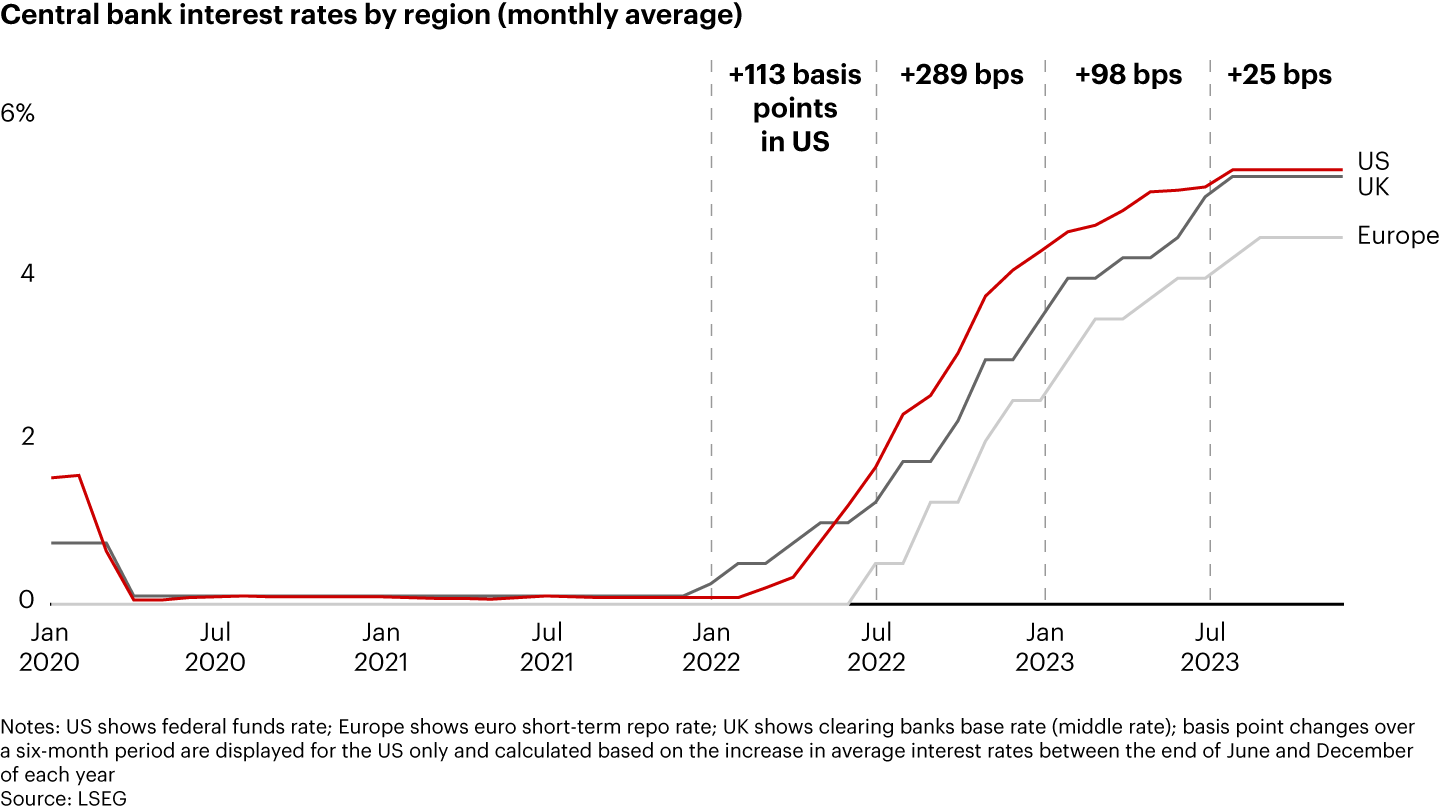
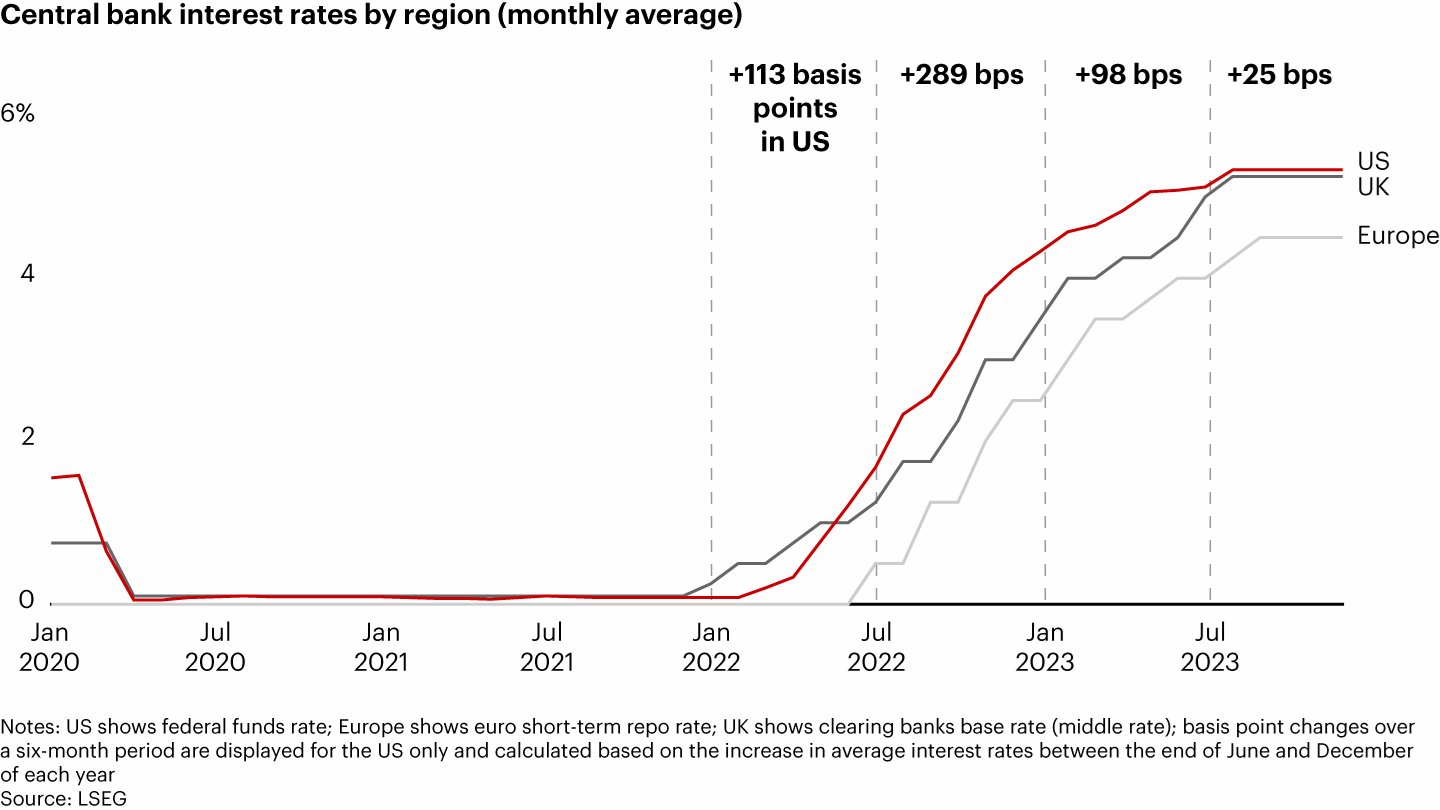
These crossed signals have left private equity hamstrung. The sheer velocity of the interest rate shock was something few in the industry had ever experienced, and the impact on value has driven a wedge between buyers and sellers.
Price multiples, which tend to move inversely to interest rates, have tipped downward over the last year, but only slightly so far. That’s because sellers are bringing to market only the highest-quality assets, those they are confident will move at a reasonable return. Otherwise, the exit channels have largely dried up, leaving general partners (GPs) with a towering $3.2 trillion in unsold assets and stanching the flow of capital back to limited partners (LPs).
These declines in activity have had a chilling effect on fund-raising. Slower distributions have left LPs cash flow negative, crimping their ability to plow more capital back into private equity. The industry still raised an impressive $1.2 trillion in fresh capital in 2023, and the buyout category attracted $448 billion. But LPs were highly selective. While capital flowed to the largest “reliable hand” buyout funds, fund-raising for most was as hard as it’s ever been.
Until GPs can begin moving assets out of their portfolios in a timely fashion, raising the next fund won’t get any easier. And the threat to returns is real. Buyouts typically involve term loans that expire in five to seven years. Already, interest coverage ratios among buyout-backed portfolio companies in the US have dropped to 2.4 times earnings before interest, taxes, depreciation, and amortization (EBITDA), the lowest level since 2007. That is pressuring GPs to both find liquidity solutions and devise new ways to generate profits through operating leverage—not just the multiple expansion and revenue growth the industry has leaned on for years.
Early signs of a turnaround? The most difficult aspect of this gridlock, of course, is predicting what will happen next. But in our view, the green shoots of a recovery are starting to poke through. Perhaps the most important is that, barring any new macro shocks or geopolitical crises, rates are more likely than not to moderate in the coming year.
Even slight cuts are likely to spur on dealmaking as long as the macro outlook remains relatively stable. Buyout funds alone are sitting on a record $1.2 trillion in dry powder, and 26% of that is four years old or older, up from 22% in 2022 (see Figure 3). That creates a heavier incentive than normal for GPs to get off the sidelines and start buying, even if conditions aren’t ideal. Activity is already ticking upward, and with help from the Fed and the European Central Bank, the bias in 2024 is likely to the upside when it comes to deal count and value.
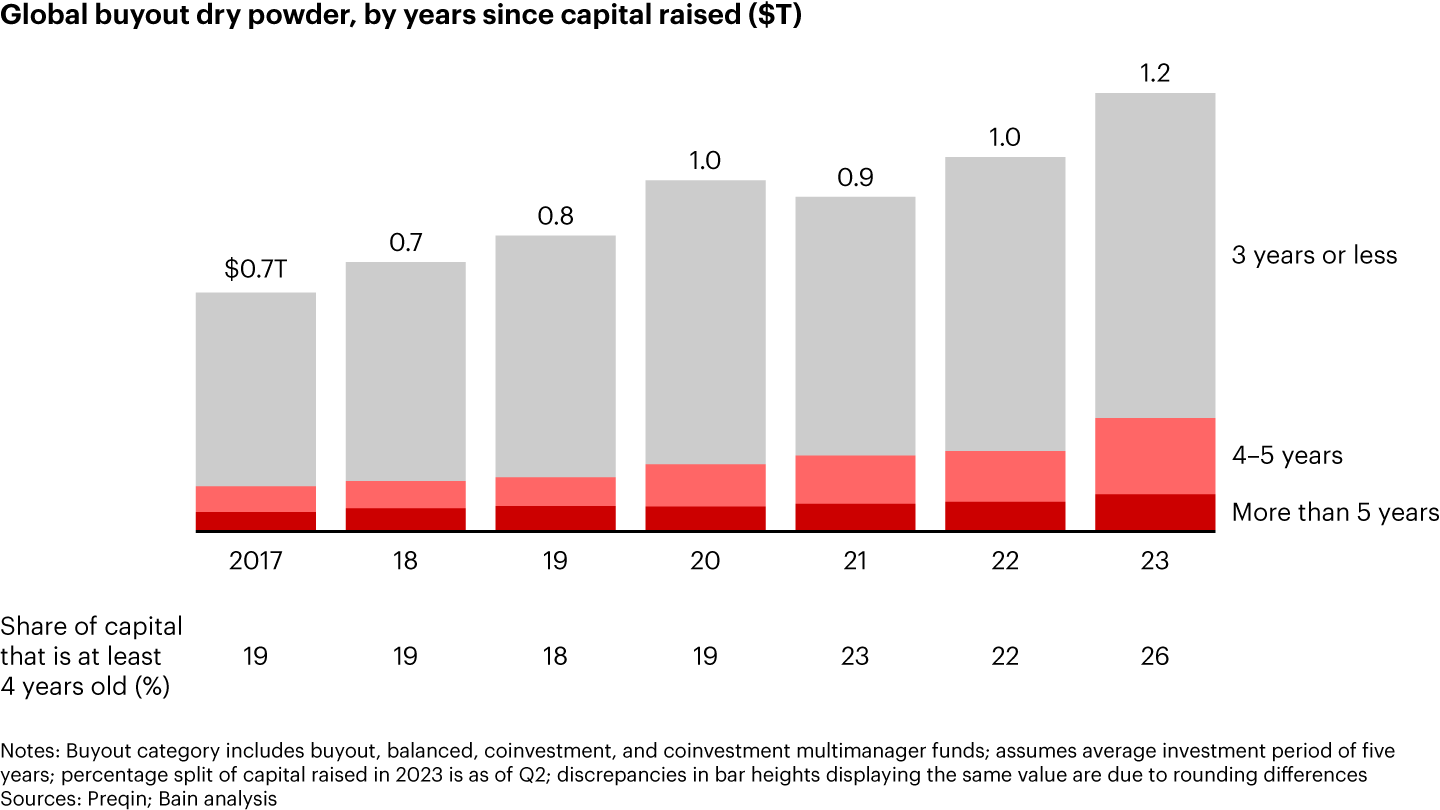
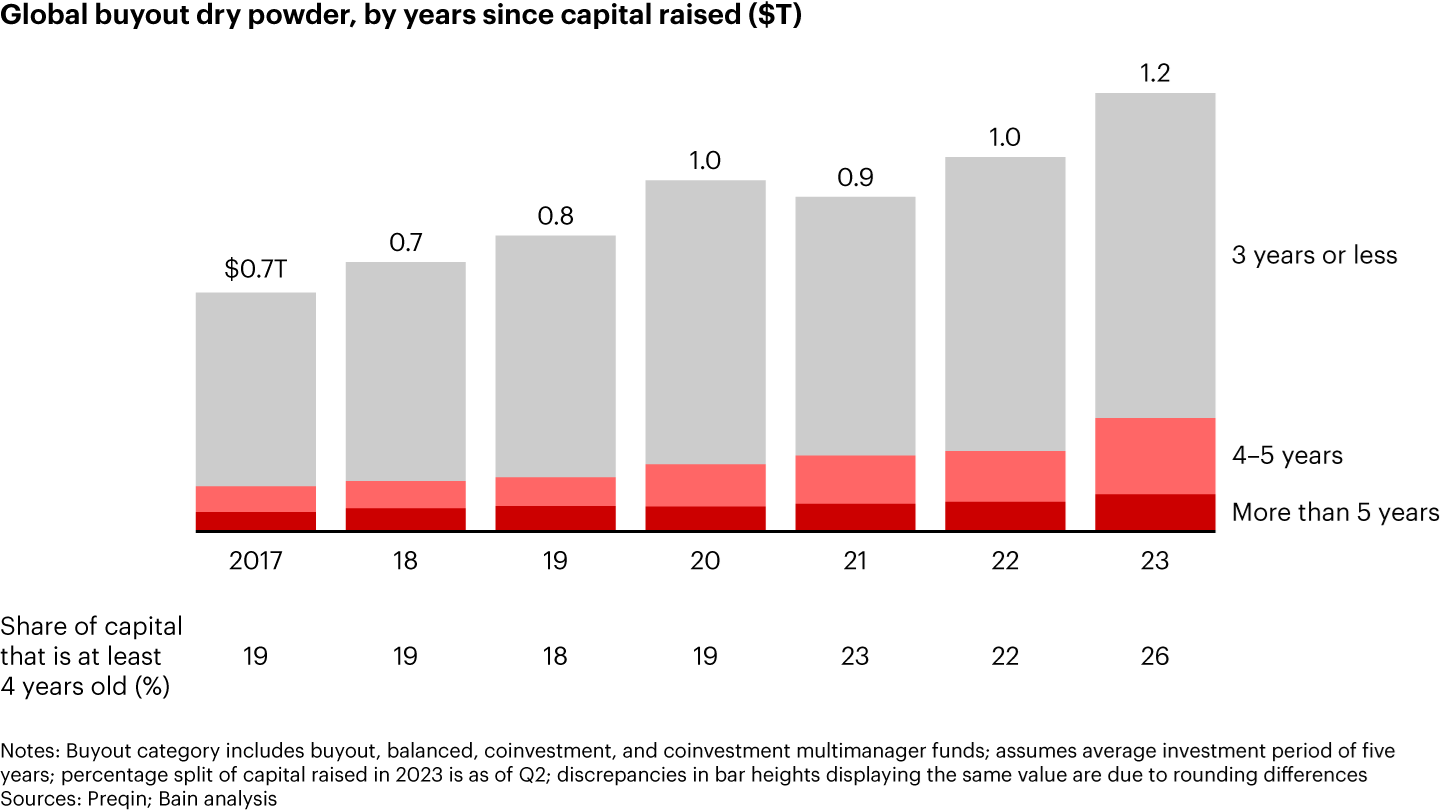
Exits are another matter. Barring a sharper-than-anticipated drop in rates, sellers will continue to face high hurdles to unloading companies to strategic buyers, other sponsors, or the public markets. With sponsors struggling to send cash back to their LPs, 2024 will likely be defined by how creative the industry can be in finding ways to generate liquidity.
Action required. What’s clear is that passively waiting for conditions to recover is not a viable strategy. Much of this report is devoted to exploring how these dynamics are playing out and what the most forward-thinking GPs are working on. Getting unstuck will demand action in several directions at once:
- Doubling down on value creation. The exit situation is shining a bright light on how critical it is to generate operating leverage in a market where tailwinds from multiple expansion have turned into headwinds. You can’t control the direction of rates. But you can get better at underwriting value and capturing it through crisp execution. We’ve talked about it for years: The industry has relied disproportionately on rising multiples and revenue gains to generate returns while margin improvement has contributed practically nothing. That no longer works when rising rates serve as ballast for asset multiples.
The portfolio companies that will stand out in this difficult market are those that have used every means possible to boost EBITDA efficiently and can demonstrate to the next owner that there’s money left on the table. That means funds have to get sharper at finding and pulling the value-creation “levers” that generate organic growth—pricing, salesforce effectiveness, and product innovation, to name a few. If these insights weren’t part of the original value-creation plan, now is the time to focus on them. The market has been abundantly clear on this. The companies that are selling are not those that have merely gotten bigger and/or leaner. The premium is on generating strong, profitable, organic growth.
- Managing across the portfolio. While strategies focused on EBITDA growth take time, a ballooning exit backlog also presents more immediate concerns. Funds need to develop a clear-eyed, pragmatic appraisal of where each portfolio company sits in terms of its return profile, its capital structure, and its future prospects. As long as rates stay elevated, GPs have choices to make: Which companies will reap an acceptable return if we sell now? Which should we sell anyway so we can return cash to LPs? Which companies face loan expirations, and where can we effectively “amend and extend” to reshape a balance sheet without too much pain? What are our options for generating liquidity through the burgeoning secondary market?
If the industry’s growing inventory of unsold assets isn’t going to be a problem, there are a few things you have to believe. First, with a large volume of portfolio companies facing refinancing hurdles, it will be critical that debt holders take the stance they did in 2008–09. Lenders clearly didn’t want the keys to a bunch of troubled portfolio companies then and probably don’t want them now. That leaves open the opportunity to pay a penalty, add some equity, and arrive at a workable capital structure.
The second thing you need to believe is that there are enough innovative solutions like continuation funds, securitizations, and NAV financing to help GPs recap prized assets and wait for returns to ripen while keeping economic interest aligned between GPs and LPs. The secondaries space is still small and somewhat controversial. But it is growing rapidly and represents the kind of financial innovation that is private equity’s specialty. We discuss this growing asset class in much more detail here.
- Professionalizing fund-raising. An effective portfolio scan should lead to a clear, practical roadmap for steering the fund through an immensely difficult period. The next step is communicating to LPs how portfolio managers are using all the tools at their disposal to act as a trusted steward of investor capital. GPs aren’t particularly adept at this kind of communication because they haven’t had to be in the past. Ad hoc, anecdotal conversations about a single portfolio company were sufficient when performance overall wasn’t really in question.
Now performance is everything, and the competition for a limited pool of capital has never been more fierce. This is spurring the most proactive funds to consider making a step change in how they approach investors by professionalizing processes and honing their go-to-market capabilities. The firms out-raising others are strategically mapping out who their LPs should be and developing the capabilities and tools necessary to understand what it takes to win with them and expand share of wallet. They are building the kind of commercial organizations the best B2B sellers rely on daily.
None of this is easy, of course, but none of it is insurmountable. Private equity survived the overexuberance of the RJR Nabisco years. It lived through 9/11 and the subsequent recession. It took the worst blows of the global financial crisis and came out even stronger. The industry, in other words, has consistently demonstrated its resilience. This is one of those moments. Time to get to work.
Here’s a more detailed look at what happened in 2023.
Investments
Private equity dealmakers tend to make the most of the cards they’re dealt. As long as they have reasonable confidence in what’s coming, they’ll find a way to make a good deal work. But confidence was the first casualty when the Fed jacked rates at the fastest pace since the 1980s, leaving the industry gasping for air. The falloff that started in the second half of 2022 bled over into 2023.
Excluding add-ons, buyout investment value dropped to $438 billion, a 37% decrease from 2022 and the worst total since 2016 (see Figure 4). Overall deal count dropped 20% to around 2,500 transactions. The steep slope of the decline was something the industry hadn’t experienced since the global financial crisis. The malaise infected regions across the world, with Europe and Asia-Pacific both experiencing significant declines (see Figure 5).
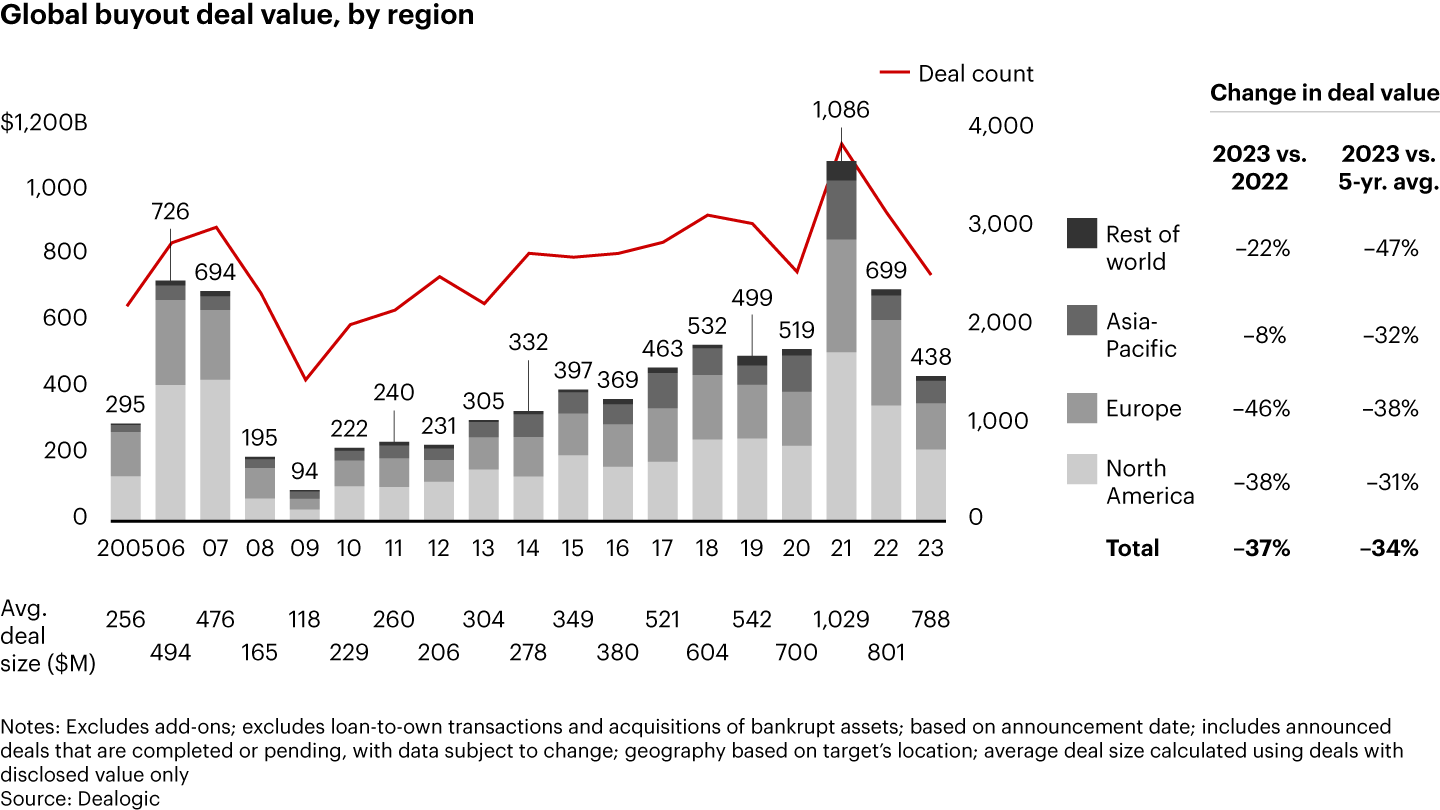
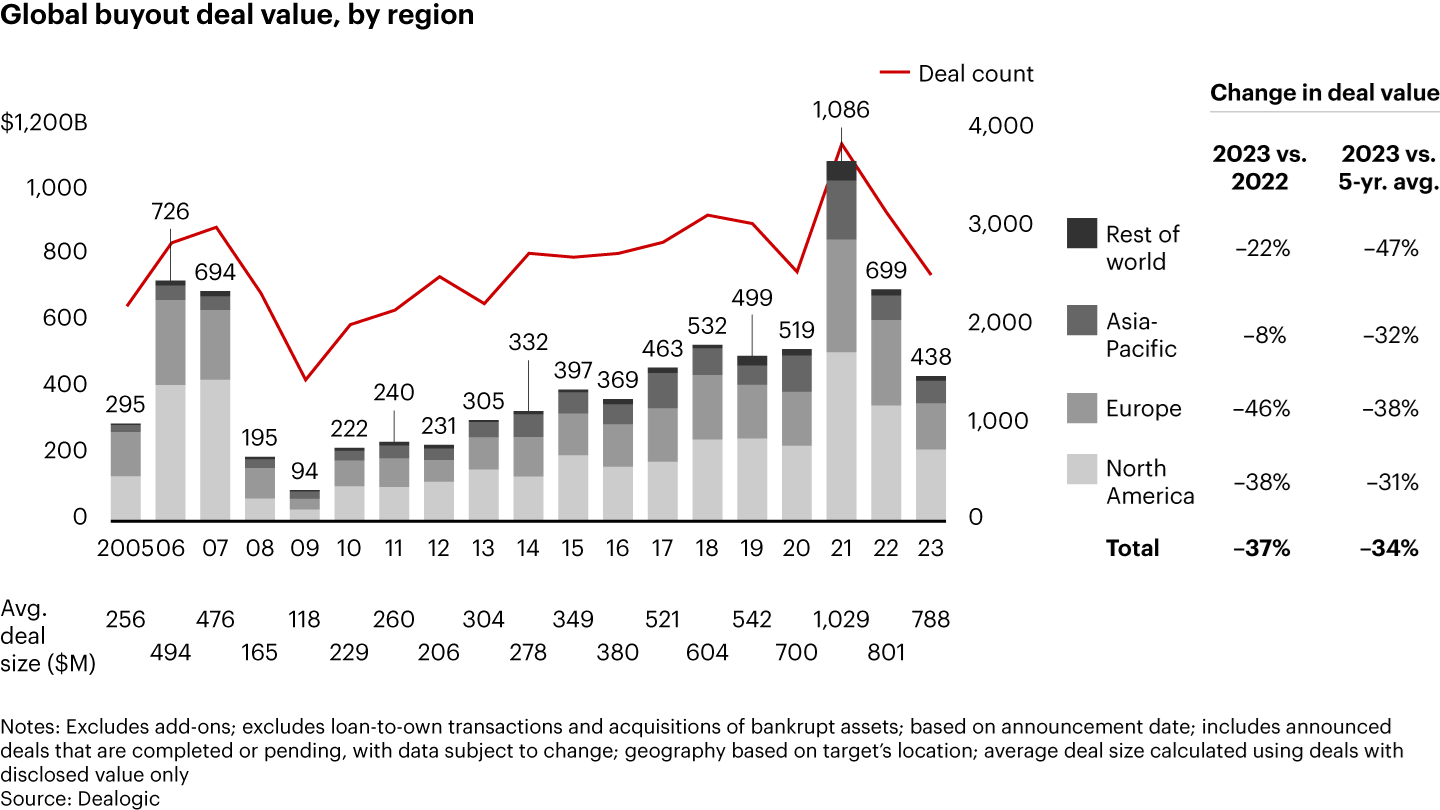
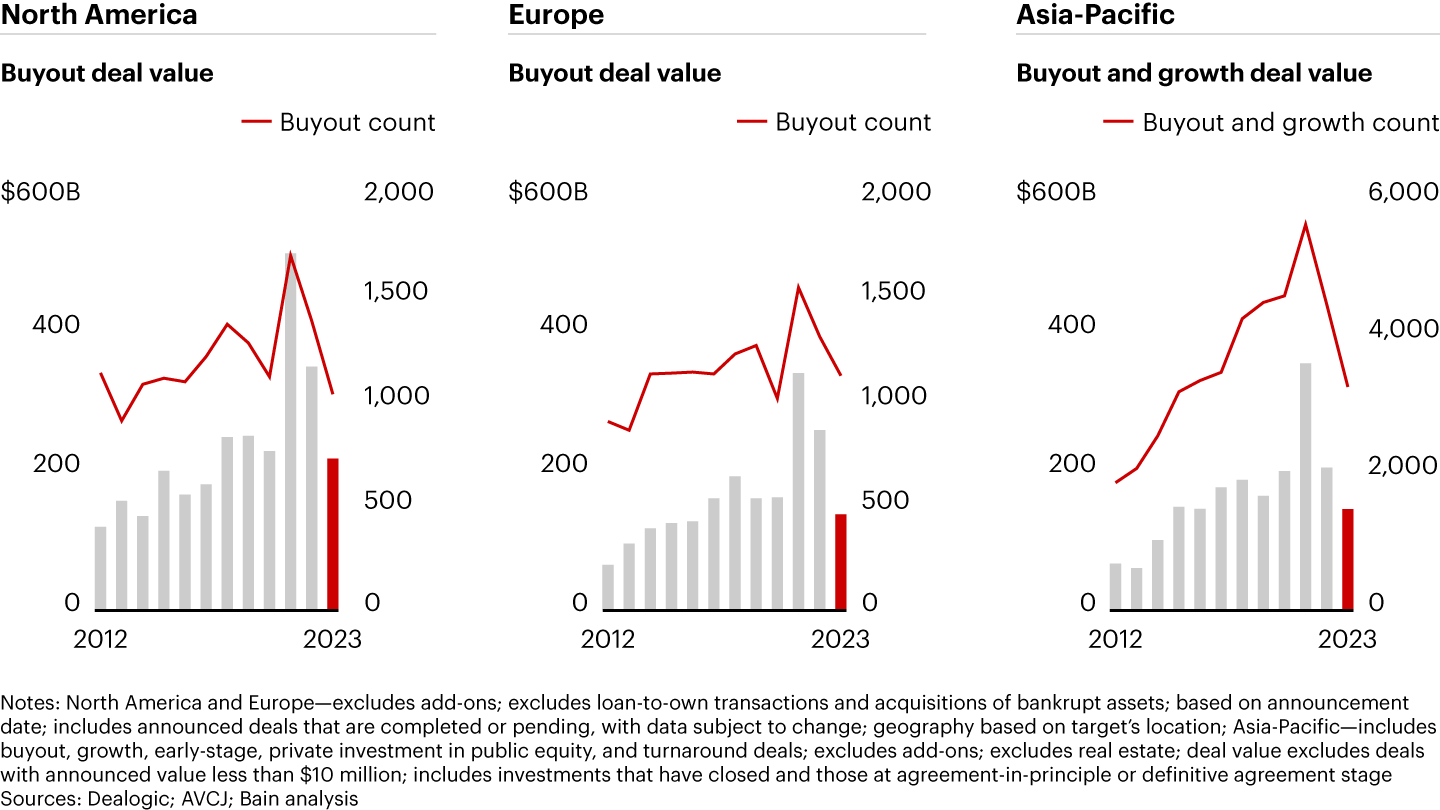

Deals of all kinds felt the impact, but those that depended on bank financing suffered the most. As yields on large syndicated loans approached 11% in the US and 9% in Europe (both 10-year highs), banks retreated and issuance of new loans plunged (see Figure 6).
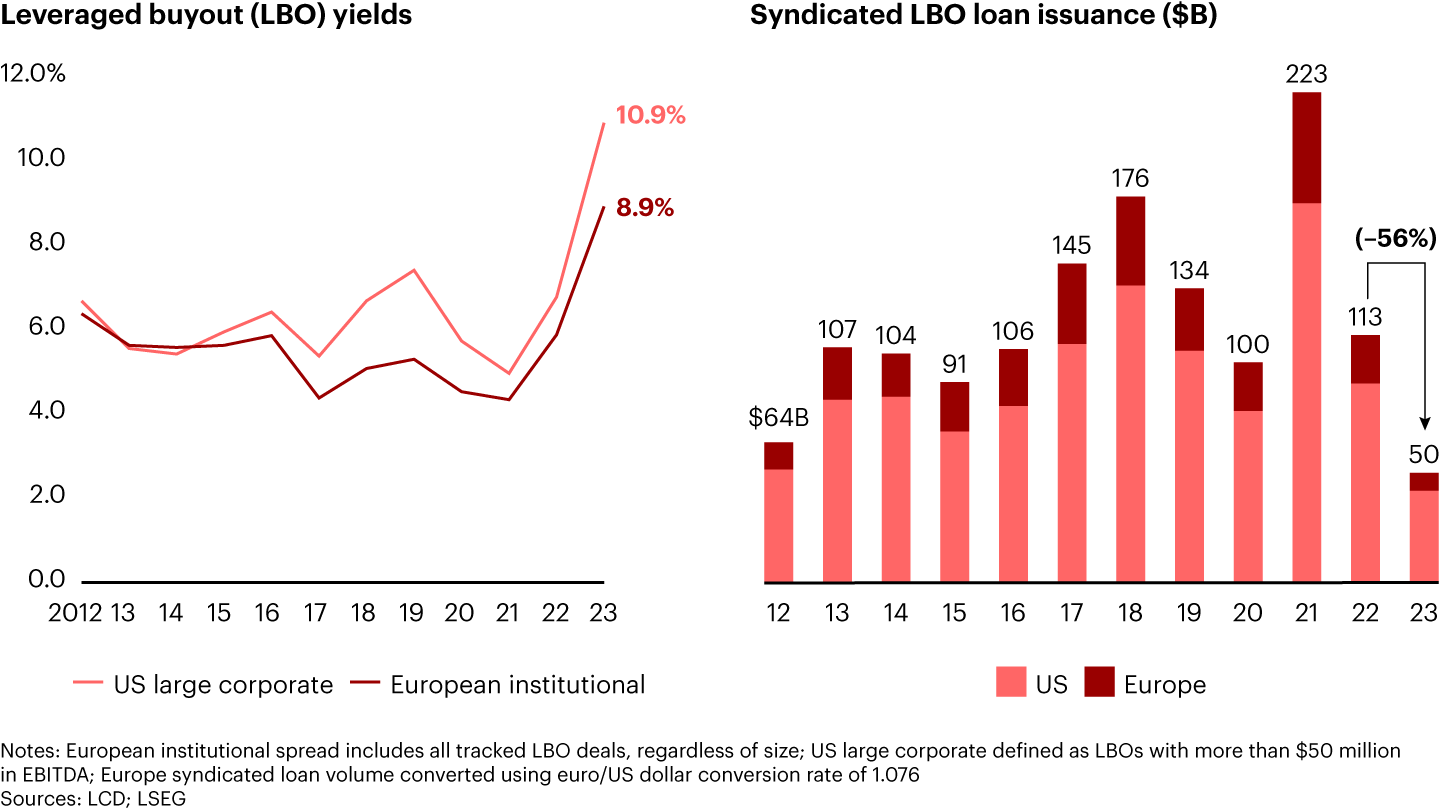

The lack of affordable leverage cut the number of megadeals—those over $5 billion—by almost half, and the average deal size dropped to $788 million, down from the peak of $1 billion in 2021. Buyouts broadly saw double-digit declines in deal count (see Figure 7). Technology deals, which by nature require less leverage than deals in other sectors, maintained their dominant share of total buyout count, but asset-heavy traditional industries like industrial goods and services expanded their share slightly, benefiting from a flight to safety among investors looking for stability wherever they could find it (see Figure 8).
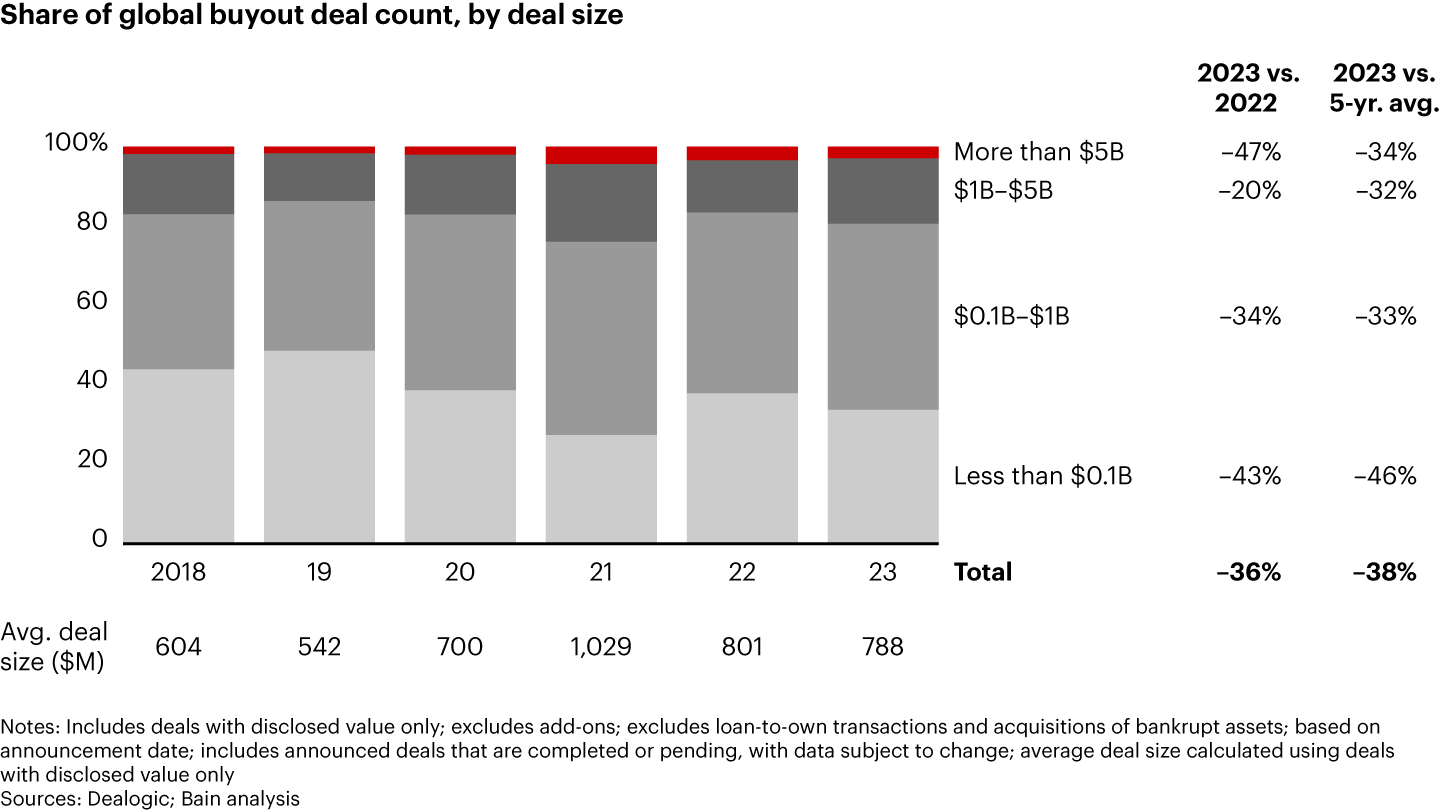
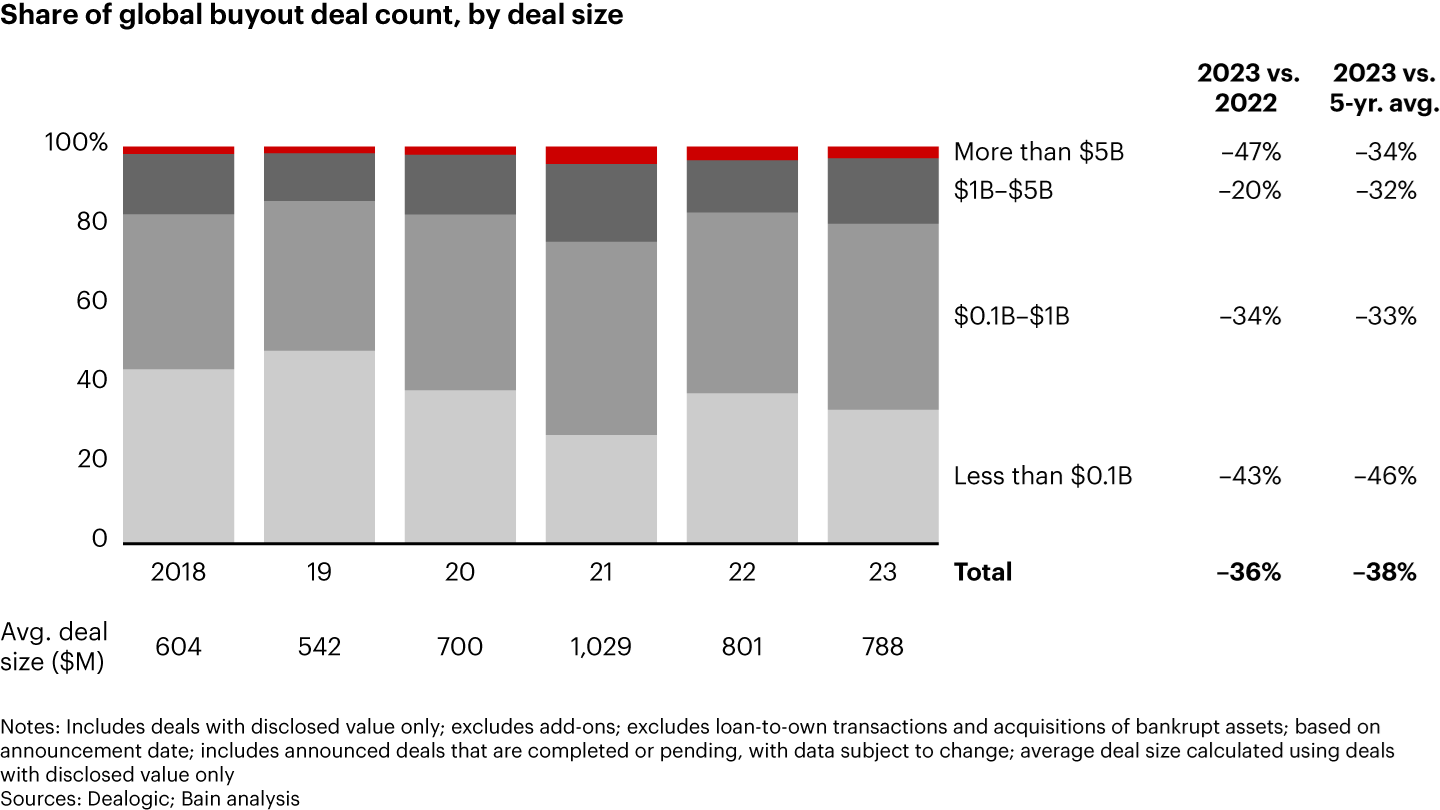
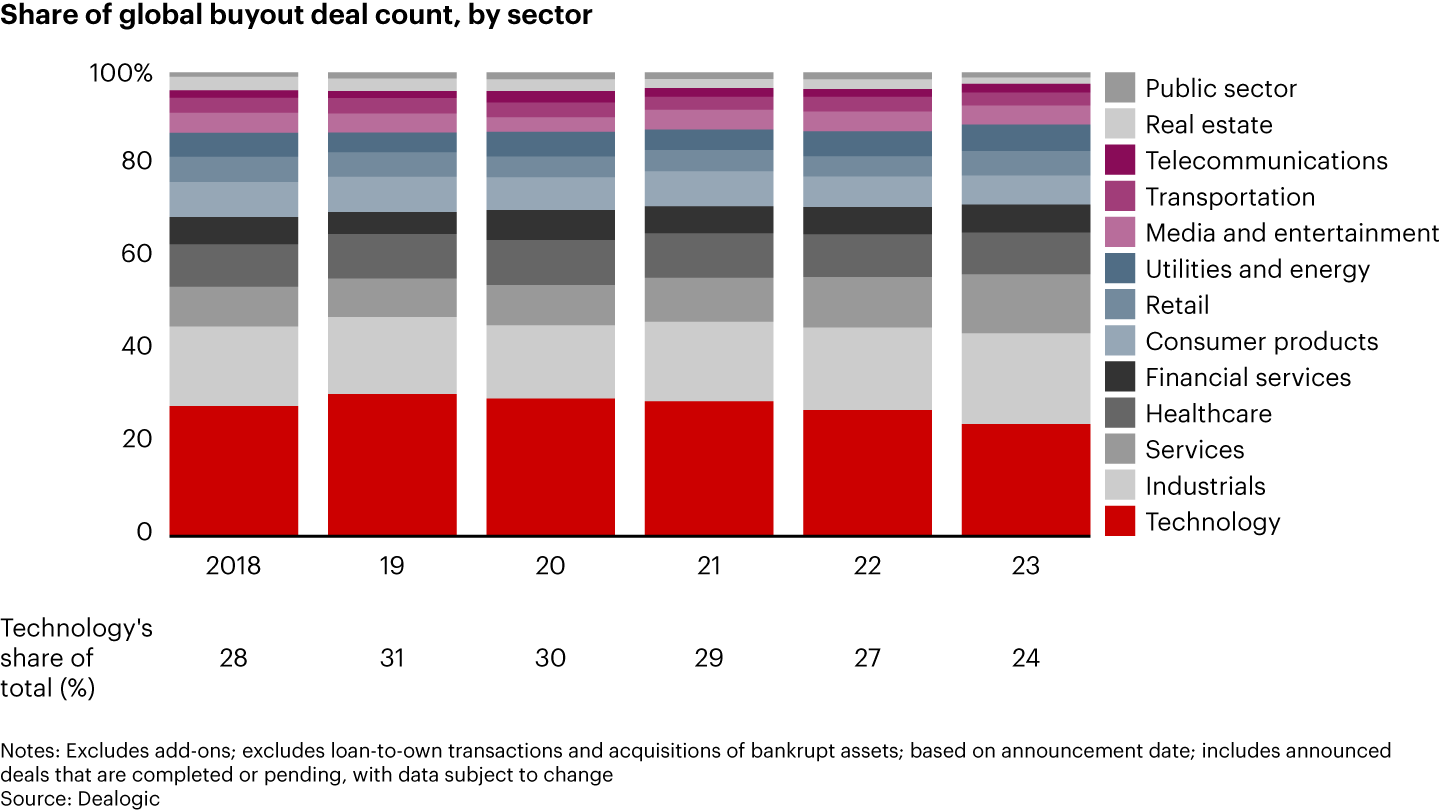
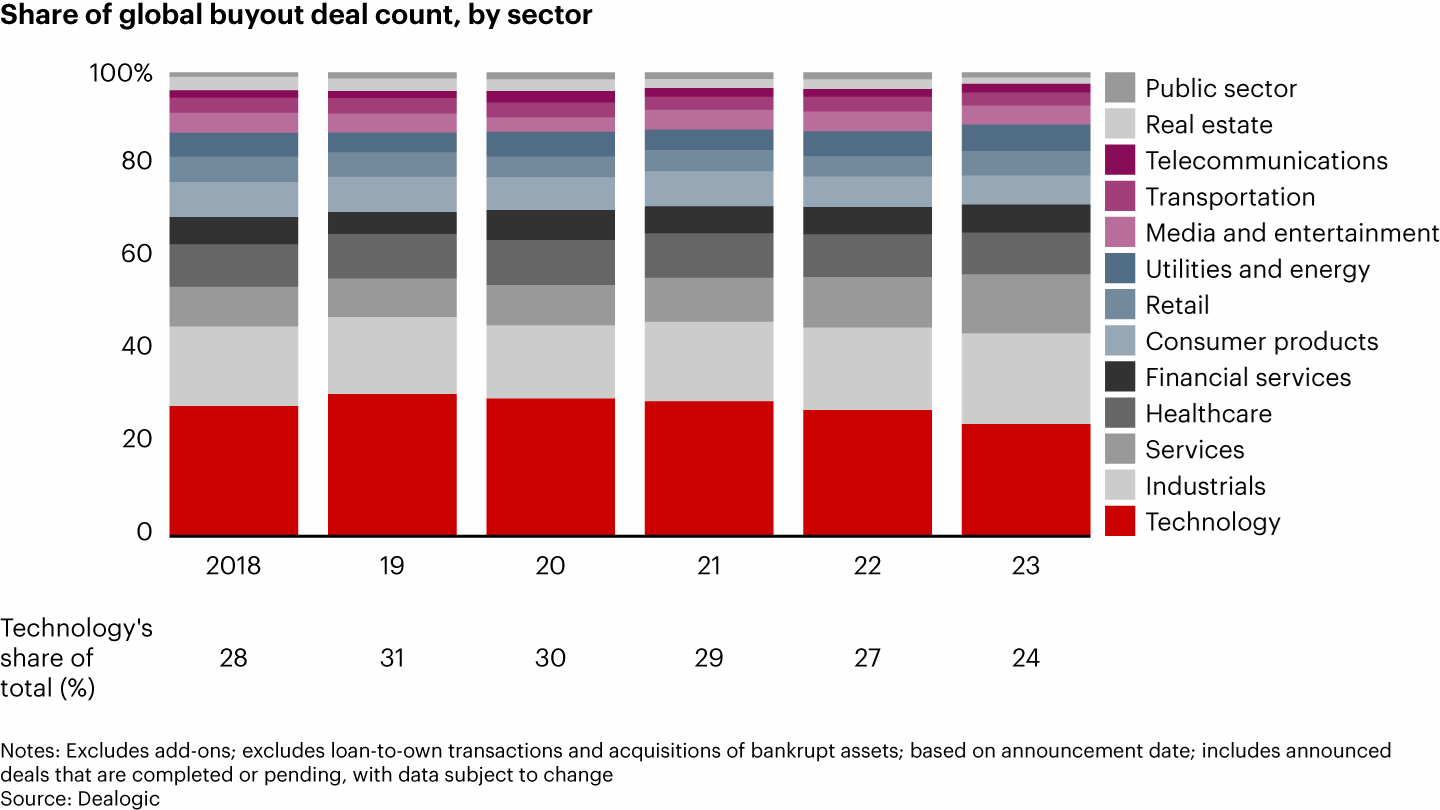
The growth and venture capital segments, meanwhile, continued to drift sideways. Both focus on riskier, earlier-stage companies whose growth-based valuations are particularly vulnerable to interest rate pressure. They were also buffeted by the lingering impact of the crypto collapse in 2022 and the implosion of Silicon Valley Bank in 2023 (see Figure 9).
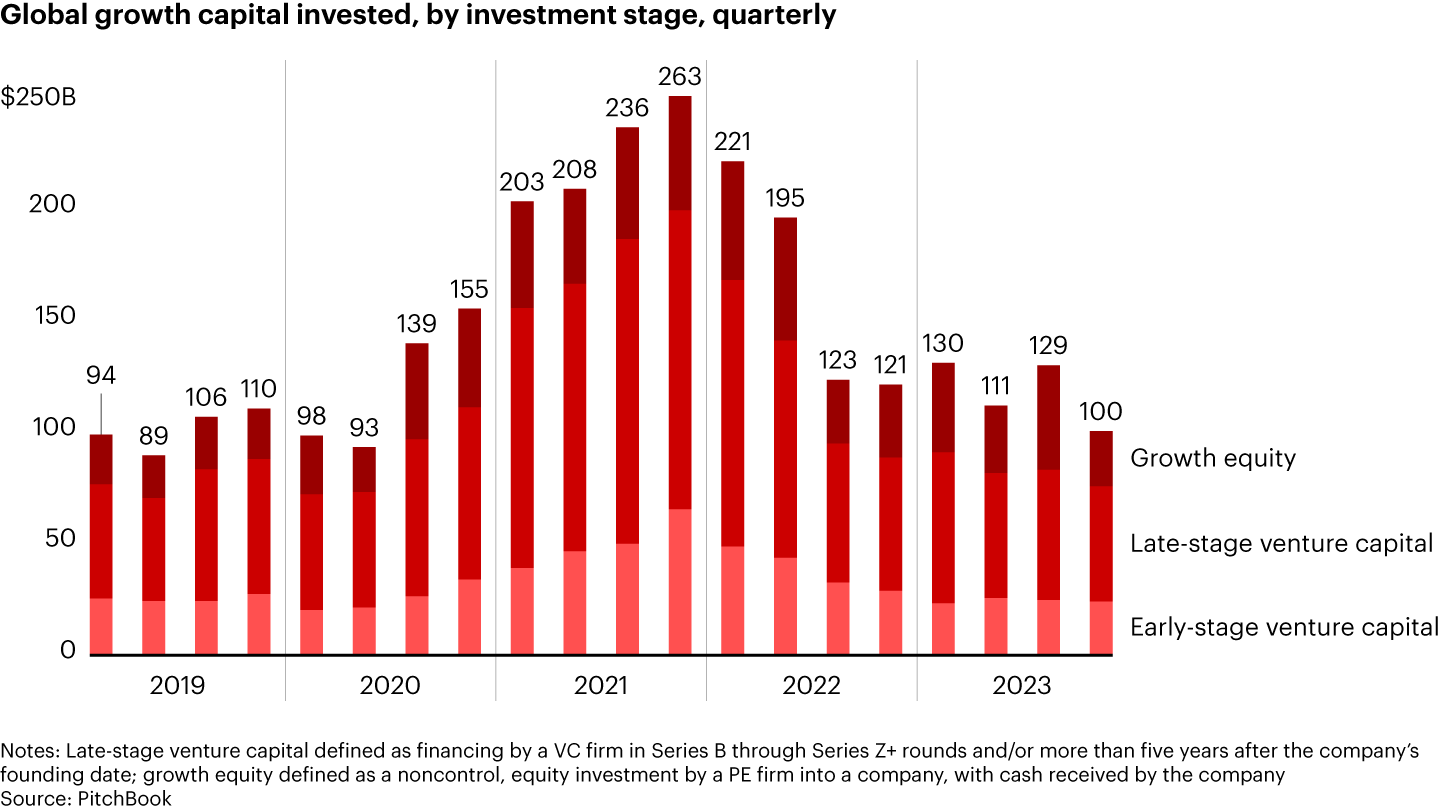
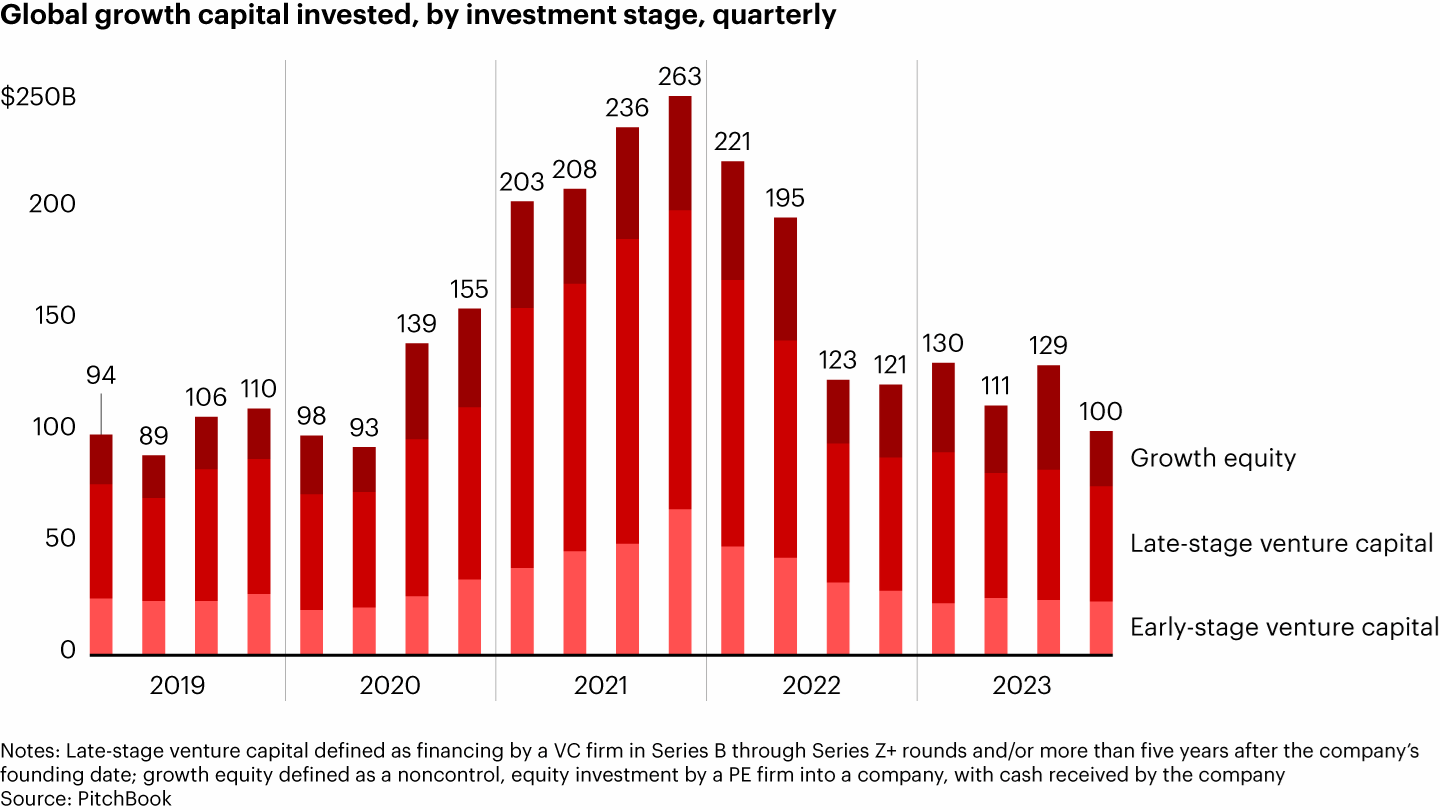
Elevated interest rates contributed to several other important shifts in the financing environment. Private credit continued to aggressively fill gaps left by the big banks and captured 84% of the middle market—deals with a total loan package of less than $500 million (see Figure 10). At the same time, investors responded to the increased financing costs by using less debt and more equity overall. Debt multiples in 2023 dropped 17% from 2022 to 5.9 times EBITDA, the lowest level since 2012 (see Figure 11). That’s not surprising given that interest coverage ratios in both the US and Europe were the worst they’ve been in years (as we’ll discuss more fully in the following section on exits).
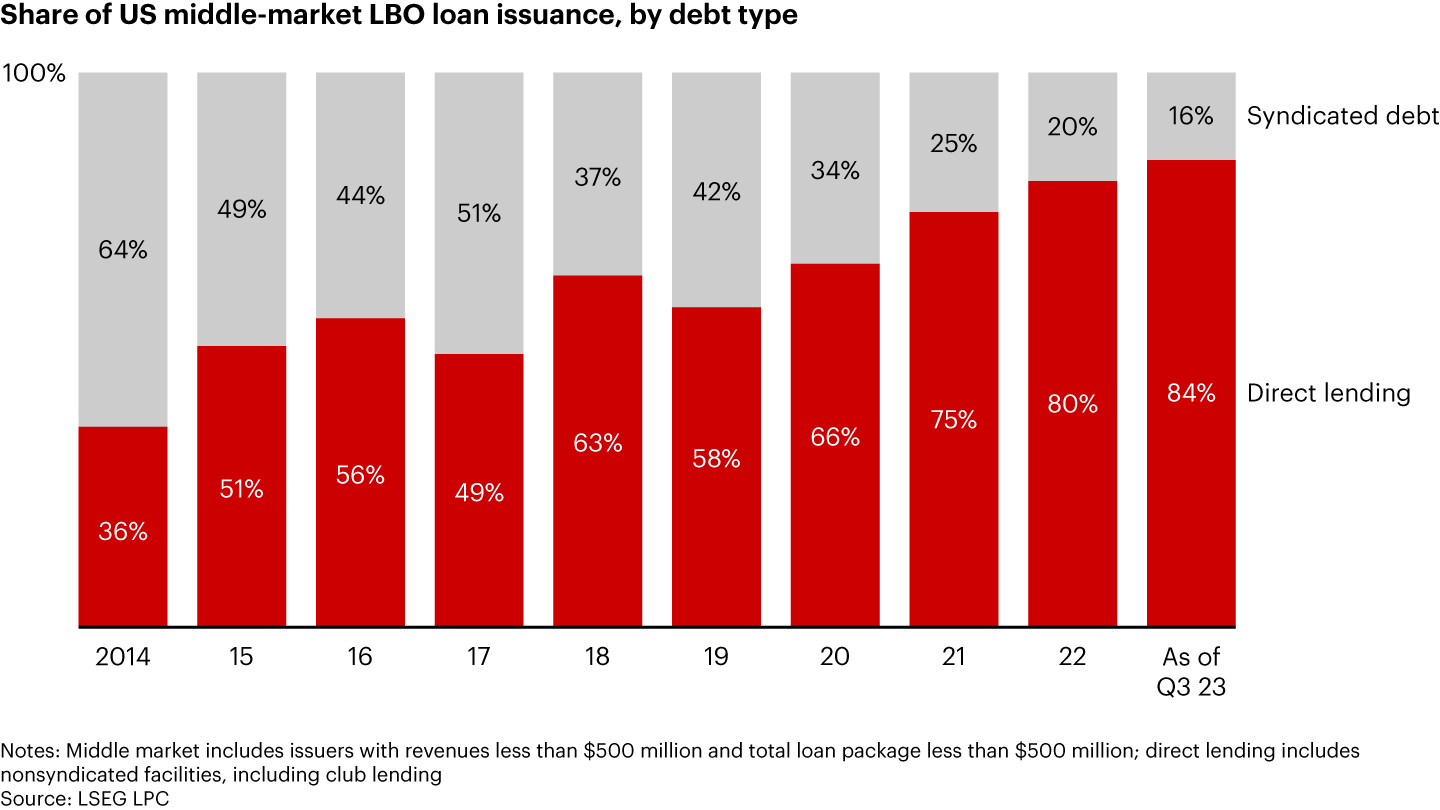
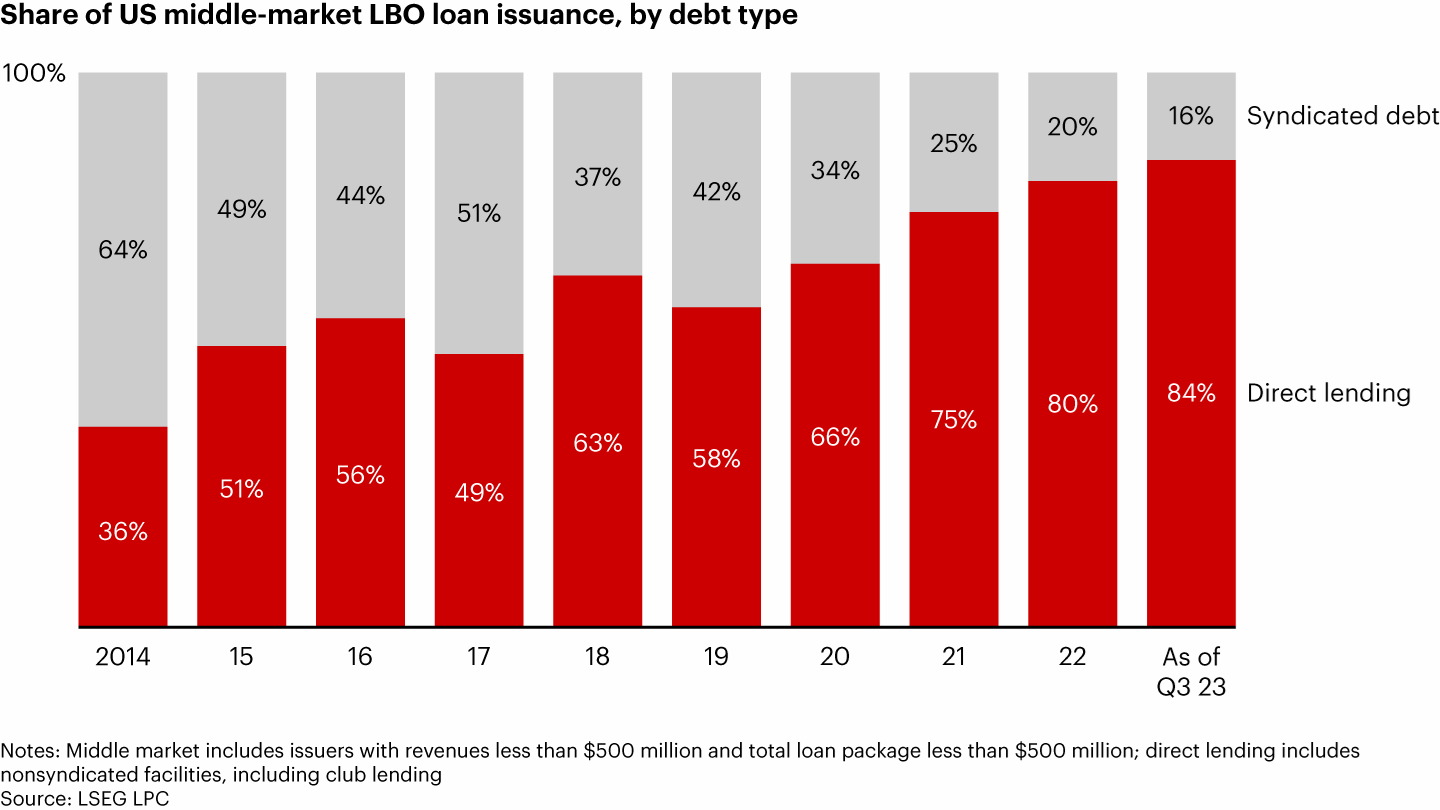
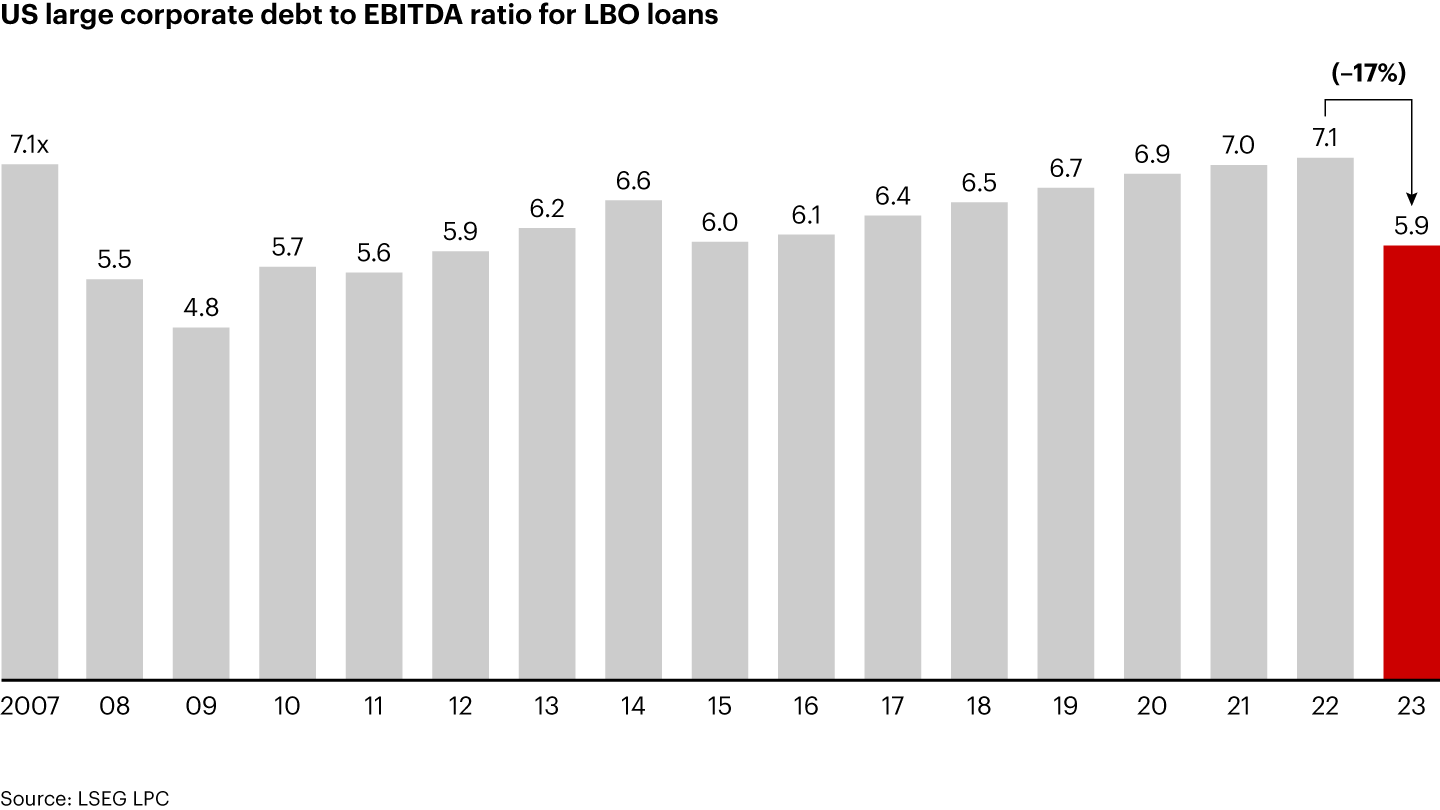
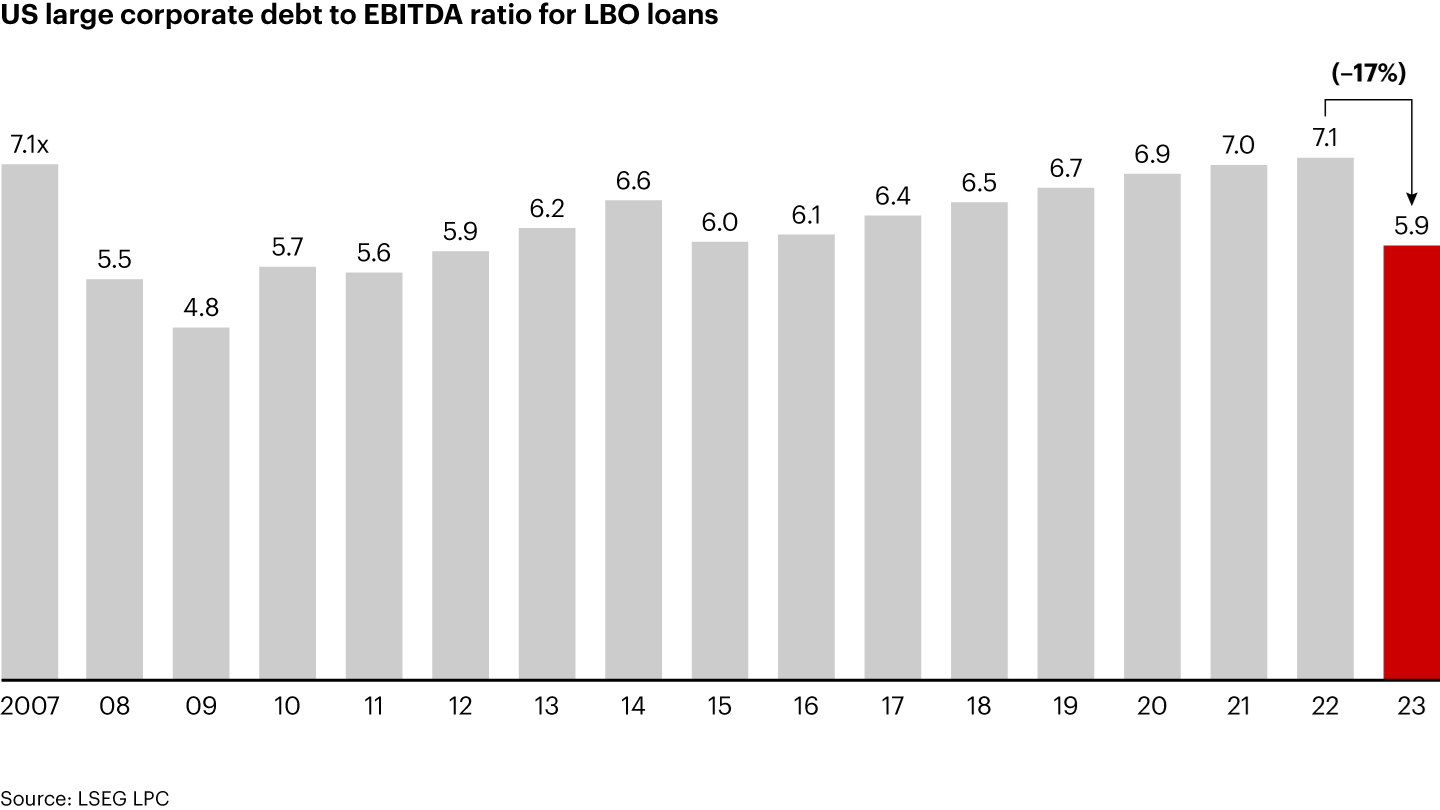
High interest rates, in and of themselves, make acquisitions harder to pencil by raising the cost of capital. But they’ve also complicated dealmaking over the past year by promising to put downward pressure on price multiples (even if prices remain relatively high historically). This is essentially a math issue: When rates go down, multiples of cash flow go up, and vice versa. Because of that, rock-bottom rates for the past decade have provided a tailwind for deals by keeping price multiples growing. That made acquisitions pricey, but if buyers could count on selling an asset for more than they paid, the math still worked.
Now the calculation is harder. Price multiples have, in fact, declined slightly over the past year, but they still sit at almost 11 times EBITDA in the US and around 10 times in Europe as sellers seek to unload the strong assets they’re confident will sell (see Figure 12). That makes the average target company expensive on a historical basis, yet it’s hard to assume that multiples will do anything but continue to ease off until interest rates begin to moderate.
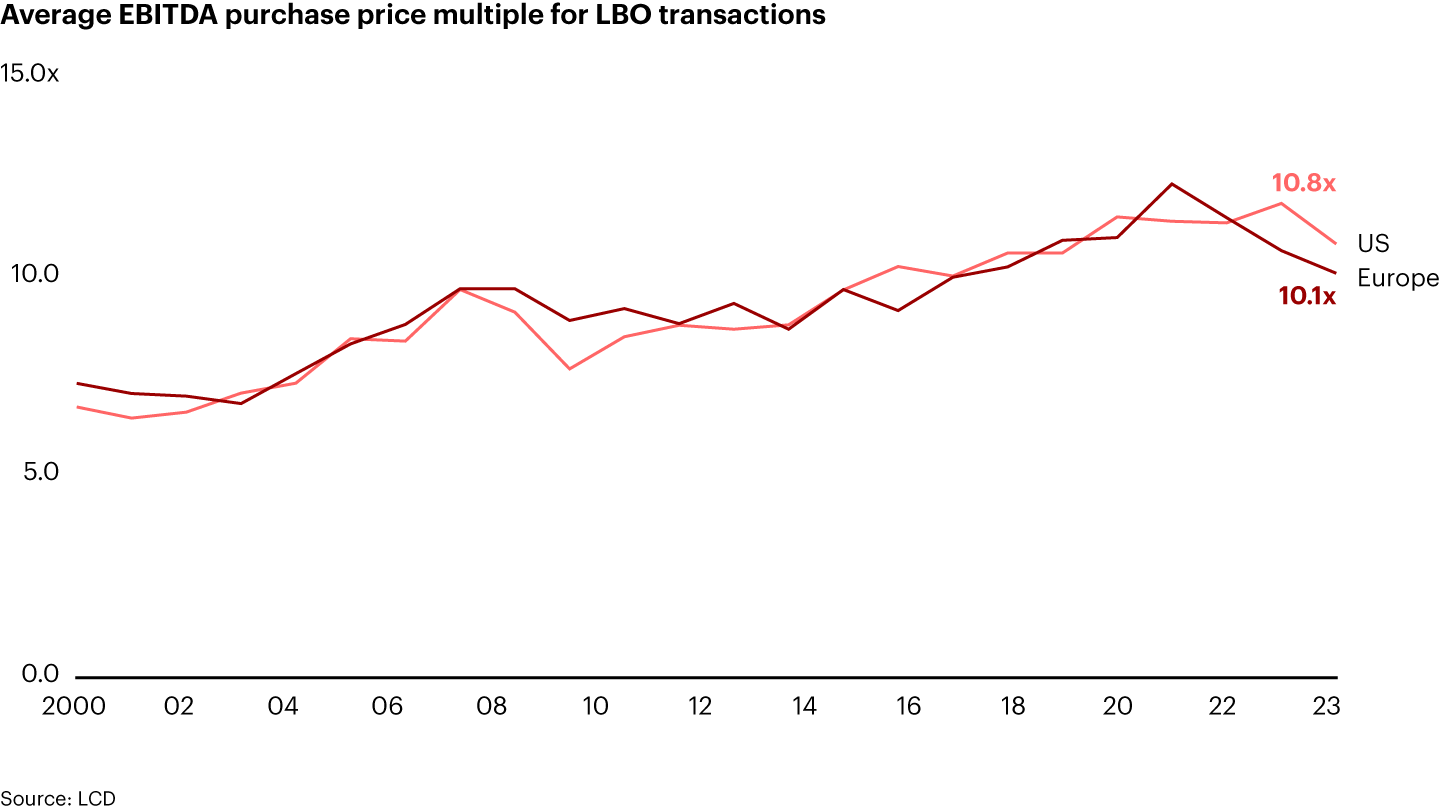
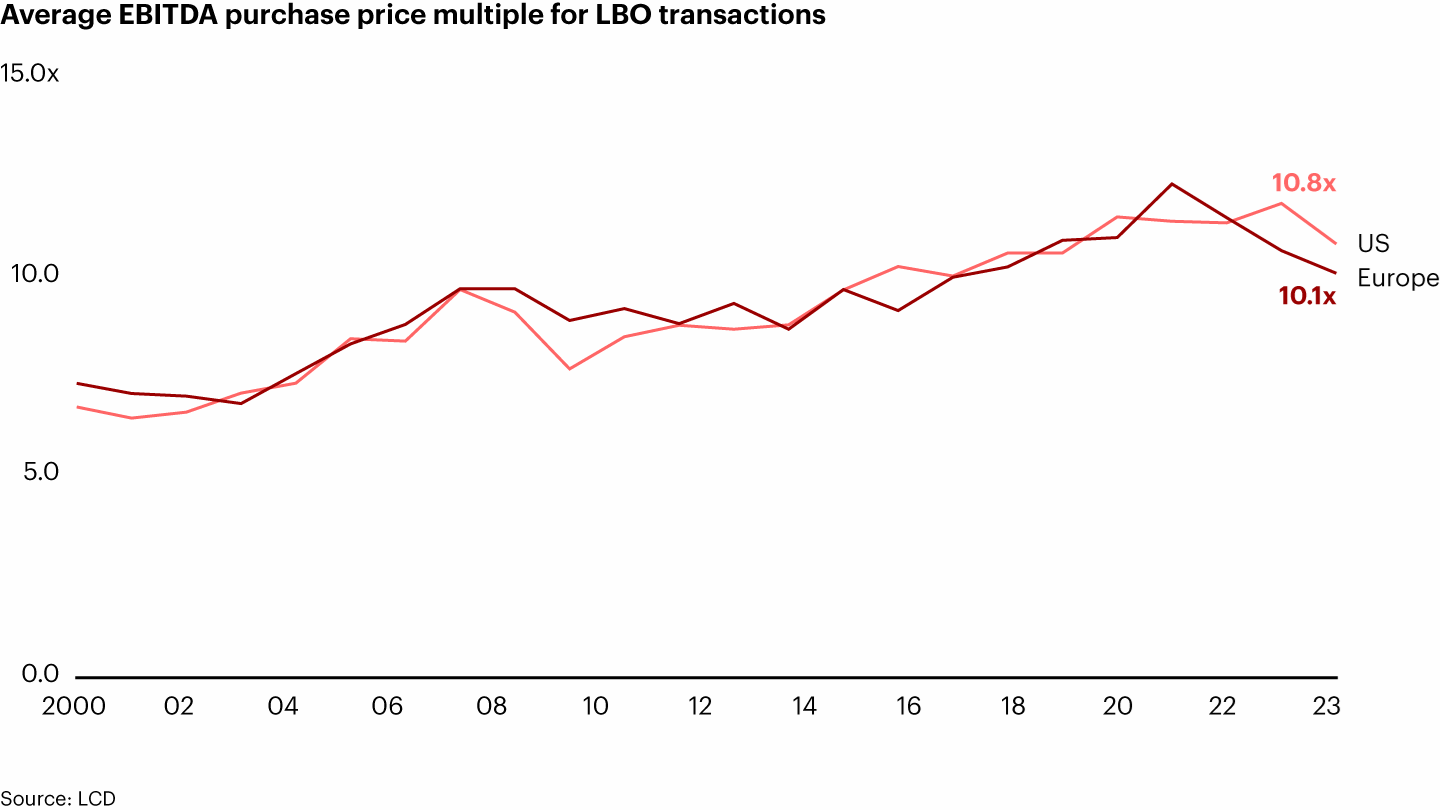
The good news, as we said earlier, is that some moderation is likely on its way in 2024 as inflation stabilizes and central bankers try their best to bring the global economy to a soft landing. Barring further shocks, a more stable—even favorable—outlook will help GPs get more comfortable with what they are underwriting. The level and age of the dry powder in their funds is also creating a heavy incentive to get moving. The industry is sitting on an unprecedented $3.9 trillion in unspent capital, the largest share of it ($1.2 trillion) in buyout funds (see Figure 13). The slowdown in dealmaking has also increased the average age of that buyout capital; around 26% of it is four-plus years old and aching to be deployed.
The potential for easing rates and the need to put money to work are why we believe investments may improve incrementally in 2024 (unless, of course, the macro environment takes a turn for the worse). But it’s equally likely that rates aren’t going back to zero any time soon, meaning pressure on multiples will endure.
Exits
Exit activity fared even worse than dealmaking in 2023, as rising interest rates and macro uncertainty left buyers and sellers at odds over valuations. Buyout-backed exits came in at $345 billion globally, a 44% decline from 2022. The total number of exit transactions fell by 24% to 1,067 (see Figure 14). Activity was slack across all geographies.
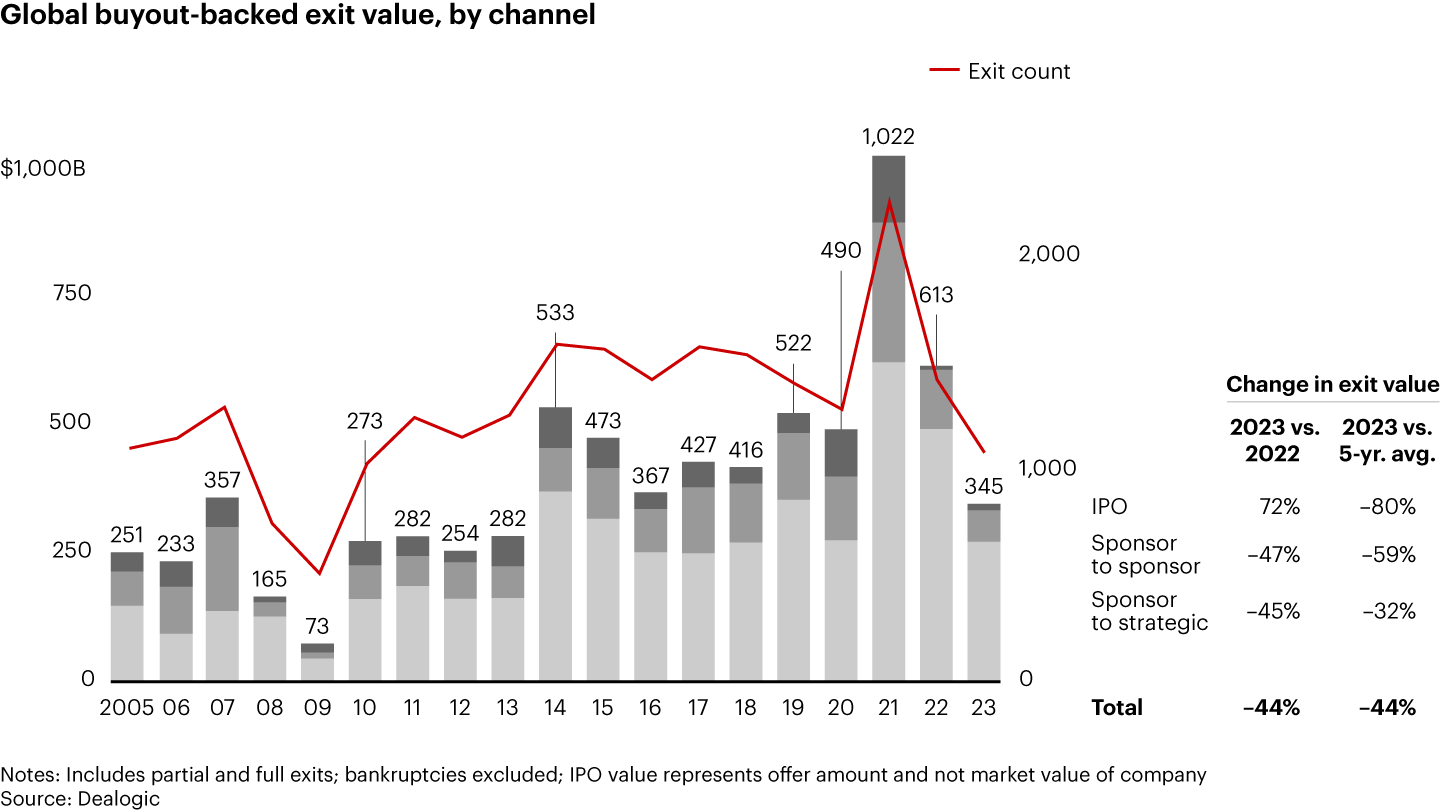
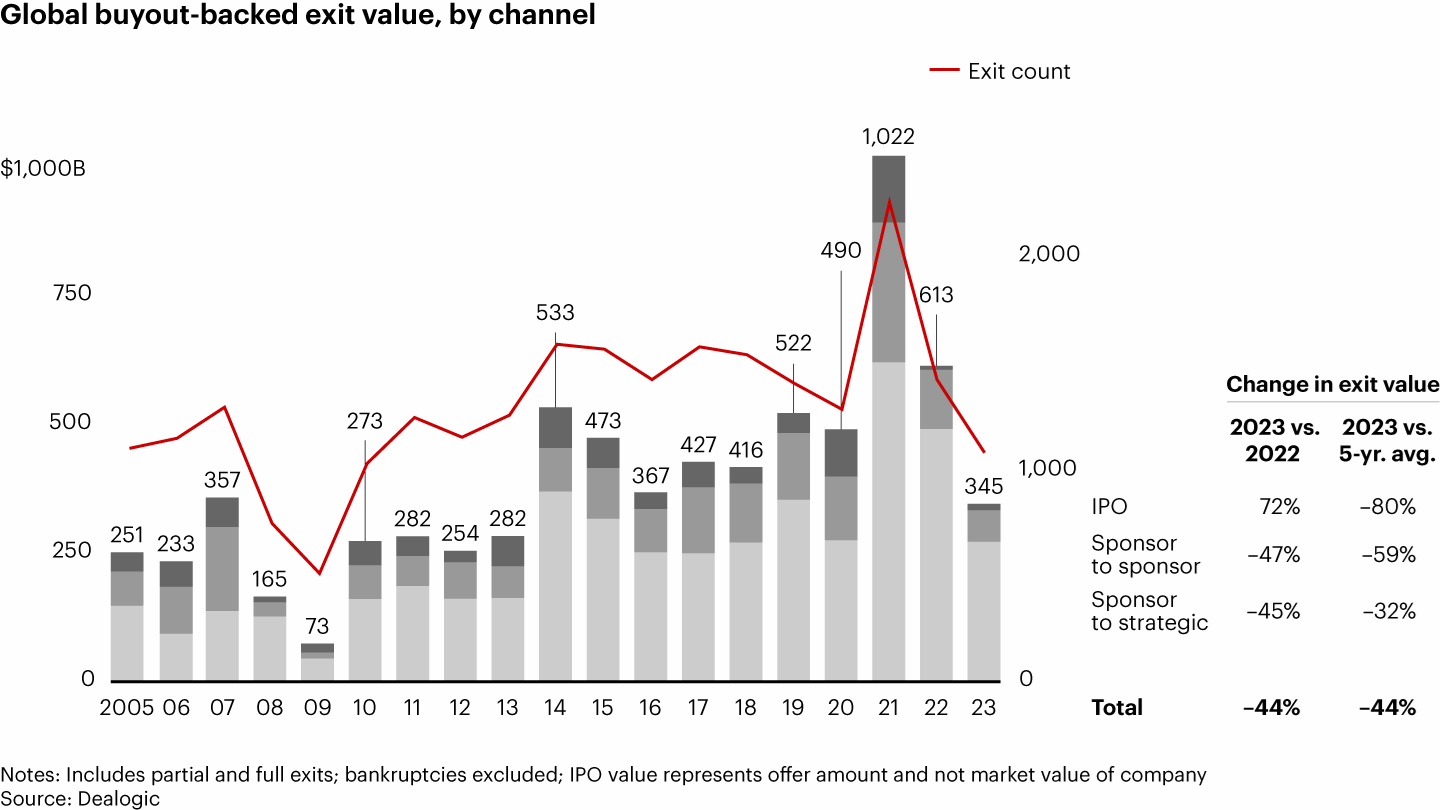
While corporate buyers remained the largest channel—accounting for nearly 80% of total exit value in 2023—the value of these strategic deals fell off 45% from 2022, to $271 billion. This was part of a broad corporate mergers and acquisitions pullback in 2023 as harried executives tried to make sense of rising rates and the uncertain macro environment.
Bain & Company research shows that corporate buyers may begin to get more active if rates stabilize and the economic outlook improves. But company executives also indicate that they plan to be significantly more selective about the assets they purchase, focusing on scale deals to accomplish consolidation objectives before returning to scope-oriented capability investing to drive growth. That suggests any recovery in strategic exits will be tentative.
The sponsor-to-sponsor channel (deals between private equity firms) was similarly challenged in 2023. The value of these transactions dropped to $62 billion, a 47% decline from 2022’s total. Higher rates meant that a potential buyer of a given portfolio company faced the prospect of spending more to borrow less as a multiple of EBITDA than the seller did when it bought the company. That left buyers and sellers facing different economics for the same asset, resulting in an unbridgeable spread between bid and ask.
Amid surprisingly strong public equity markets in 2023, the IPO exit channel showed some signs of life, rising to $11.8 billion from $6.9 billion in 2022. But it still made up just 3% of total exit volume and is unlikely in the coming months to provide consequential relief for an industry struggling to generate higher distributed to paid-in capital (DPI).
Indeed, unless rates drop meaningfully in 2024, none of these exit channels is likely to rebound vigorously in the short term, and the deals that do close will skew toward large companies and those with the strongest fundamentals. Buyout funds, meanwhile, will be challenged to make a meaningful dent in the $3.2 trillion in unexited assets sitting in their portfolios (see Figure 15).
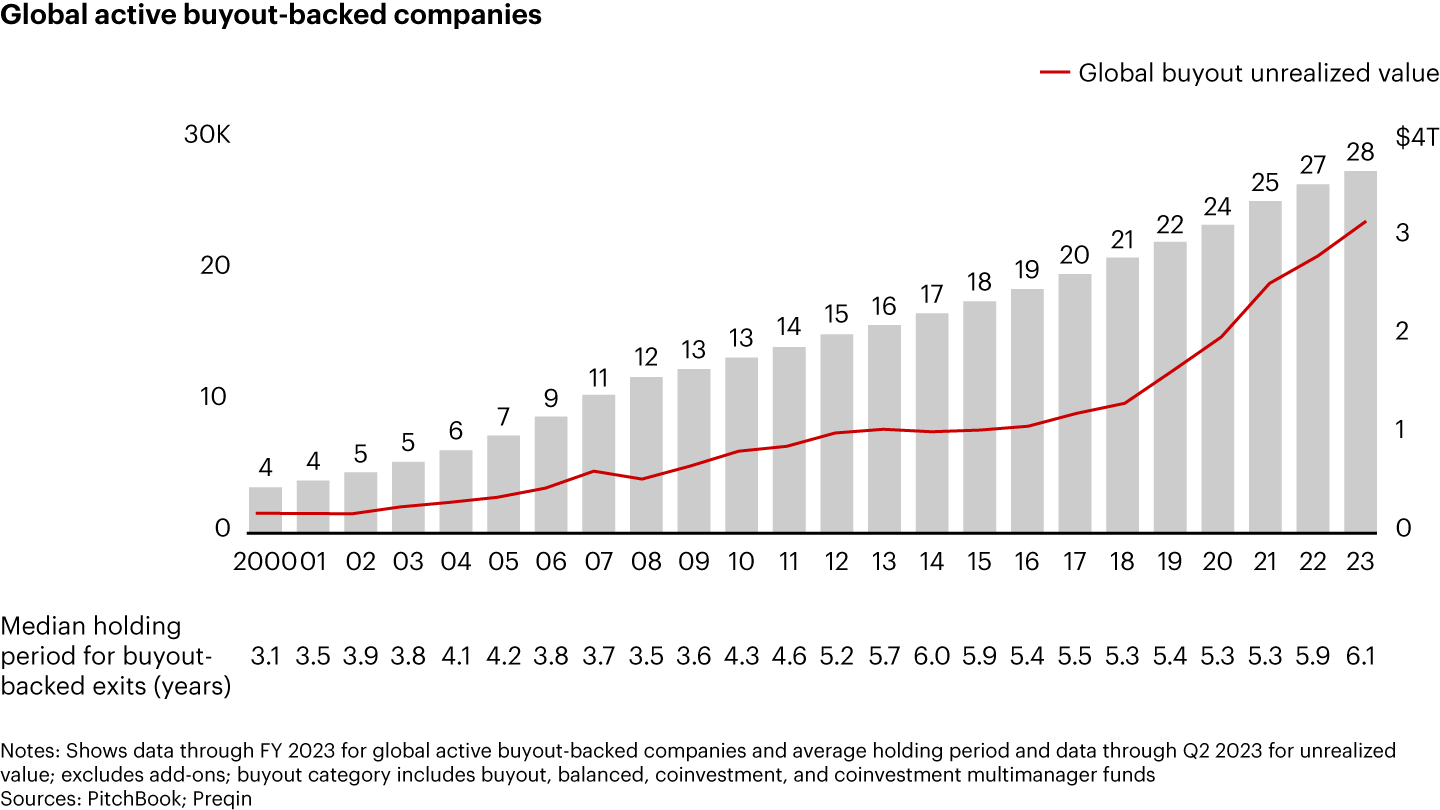
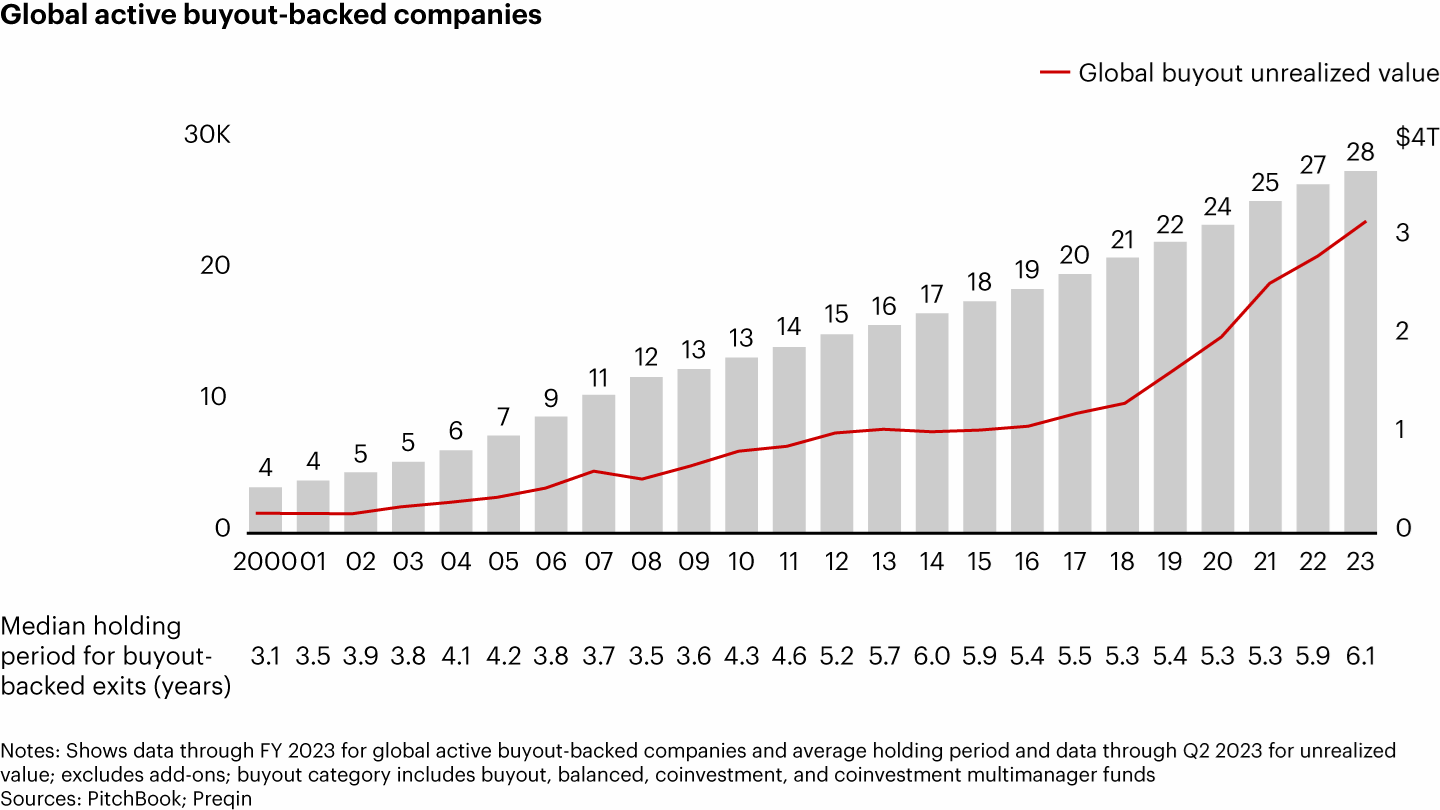
This will focus GPs on two overarching objectives. First, they will need to boost DPI in the near term by determining which assets they can sell (both old portfolio companies and newer ones) and aggressively chasing those opportunities. Second, they will need to manage the balance sheets of the companies they hold and develop strategies to increase EBITDA.
Over the past two years of inflation followed by monetary tightening, interest coverage ratios among buyout-backed companies have dropped sharply to 2.4 times cash flow in the US and 2.6 times in Europe (see Figure 16). Those are the lowest levels since 2008 and suggest that, for the average buyout-backed portfolio company, paying off interest has already gotten significantly harder. In 2023, according to Dealogic, $95 billion in leveraged loans came due and presumably had to be refinanced at higher rates. And by year-end 2025, loans worth more than three times that amount (approximately $300 billion) will mature, making life difficult for GPs who have yet to exit them (see Figure 17).
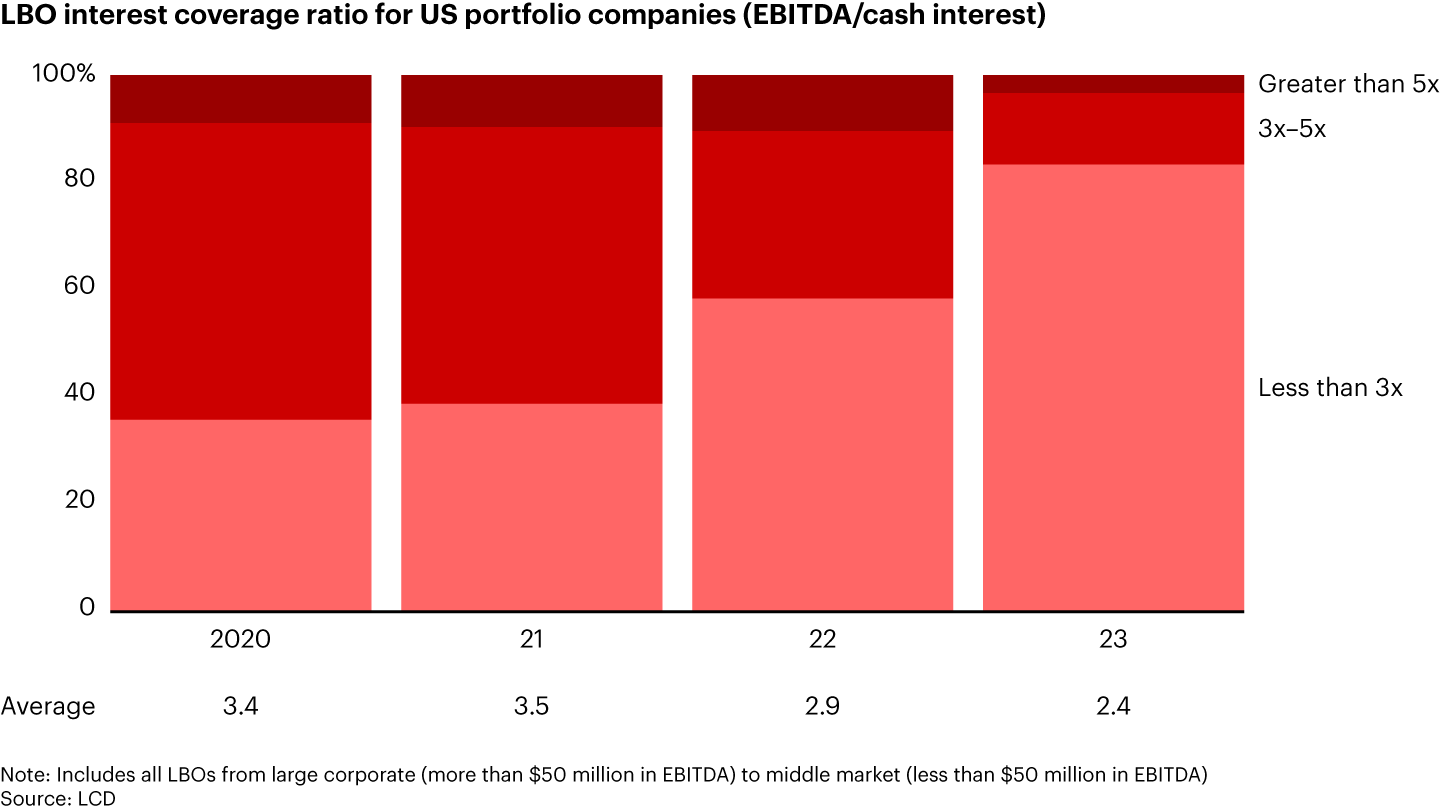
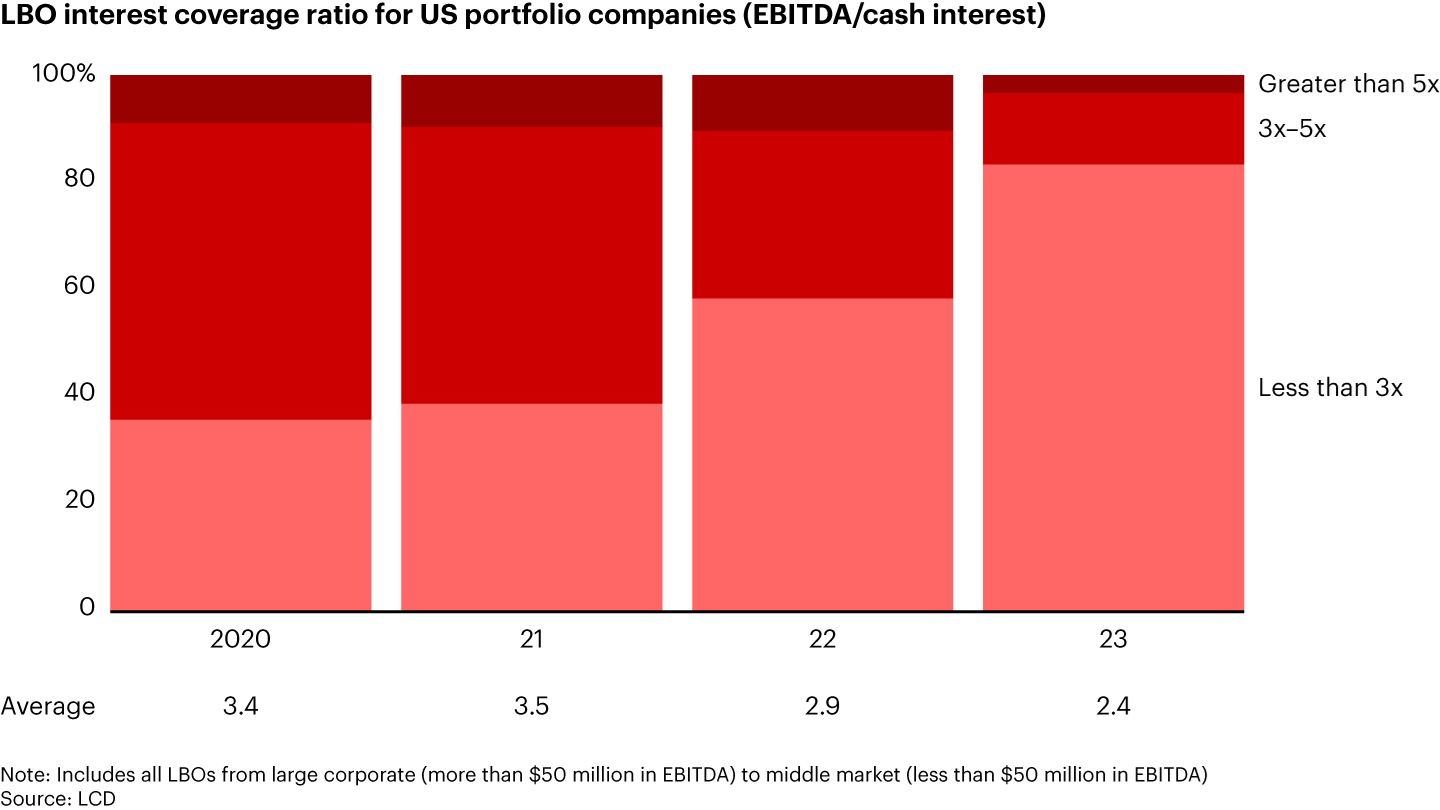
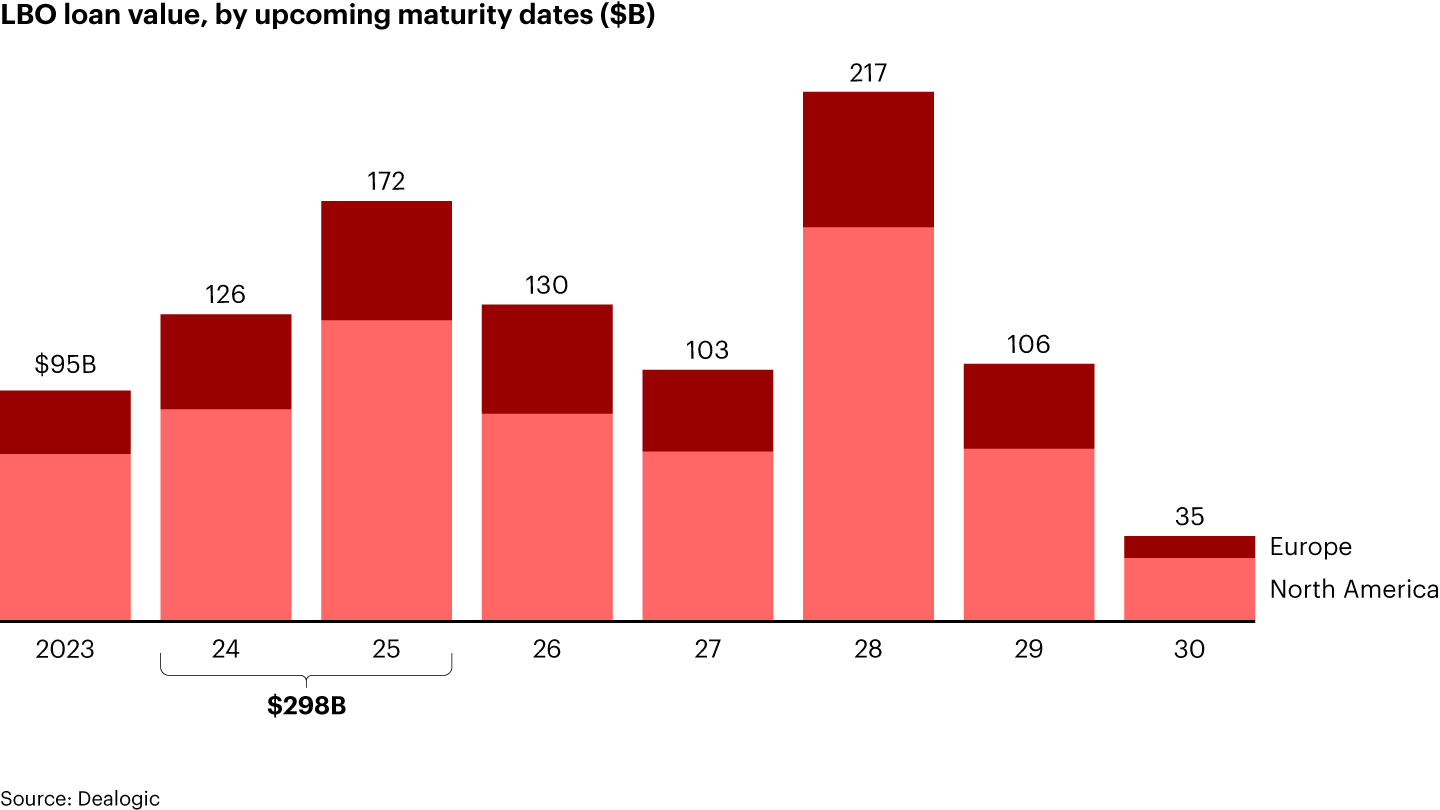
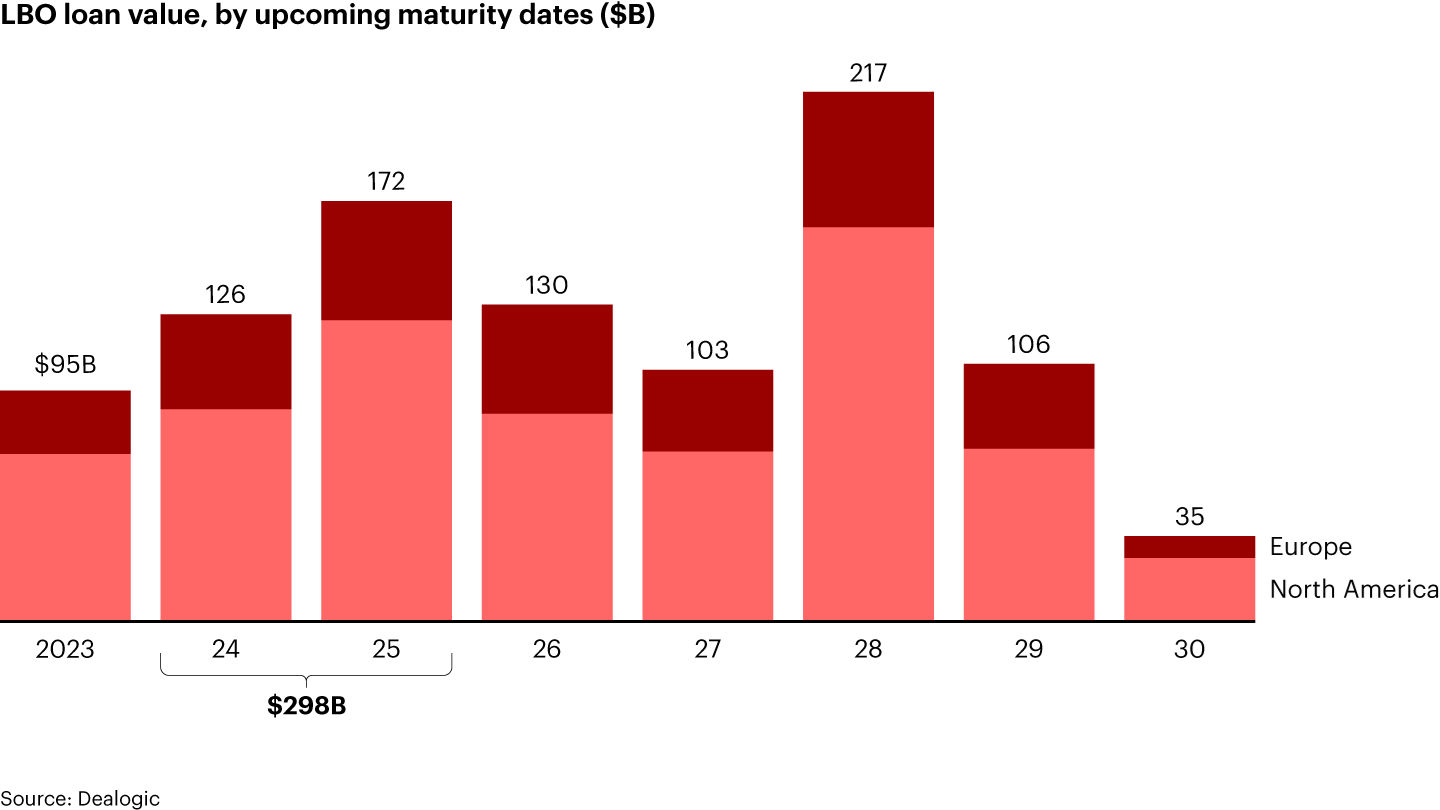
Because boosting EBITDA is the most potent bug spray against higher interest expense and the best foundation for a stronger exit story over time, the most proactive GPs are doubling down on value creation as they wait for the exit channels to improve. But what if refinancing needs outpace the firm’s ability to generate stronger cash flow?
During the GFC, many GPs bought back debt in their portfolio companies that was trading at a deep discount amid the economic malaise. The bet was that those companies would outlast the recession and the debt would eventually bounce back, actually enhancing the overall return.
With rates high and recession at bay, that’s not an option today. But GPs are actively exploring other solutions. A few examples:
- For those with undrawn equity capacity, one alternative is to inject enough new equity into a company to make debt affordable, avoid diluting returns, and maintain 100% control—essentially kicking the can down the road for the price of the equity infusion.
- Another strategy is to use NAV loans to borrow against the portfolio—not individual companies—to effectively cross-collateralize assets. That’s using strength to mitigate exposure, but it does lock in a potential drag on the entire fund.
- Other funds are creating new securities out of single assets in need of refinancing through innovative continuation vehicles that take out debt and reset the cap table. LPs can roll their positions or not, and the GP retains economics in the new structure.
Weathering this period of exit stress will clearly depend on innovation. GPs need to sell what they can and buy time to hold good assets while maintaining aligned incentives with LPs and management teams.
Fund-raising
Probably the most generous way to think about 2023 fund-raising is that it contributed an impressive $1.2 trillion to the stunning $7.2 trillion in fresh capital the industry has accumulated since 2019 (see Figure 18). Whether you saw any benefit from that windfall, however, depended on where you sat.
The amount raised in 2023 was actually the least the industry has pulled in annually since 2018—down 20% from 2022 totals and almost 30% off the all-time high in 2021. The decline reflects the cash flow constraints LPs are facing due to the exit slowdown and accelerated drawdowns in recent fund-raising vintages (more on this below).
Buyout funds, which raised 18% more capital year over year, were the only major category to post gains as LPs focused allocations on the funds they trust most. The exception was secondaries, which roared ahead by 92% (off a smaller base) as investors spotted opportunity in a category of funds aimed at solving the industry’s liquidity woes. Other than that, however, funds struggled. The darlings in the run-up to 2021—growth, venture capital, and infrastructure funds—all declined sharply.
Even within buyout, there were distinct winners and losers as LPs gravitated to size and perceived quality (see Figure 19). Allocations clearly favored large funds, with the top 20 funds raising a disproportionate 51% of capital aimed at buyout. But girth wasn’t all that mattered; the premium was on performance and balance. Several lagging megafunds had to cut targets, and LPs pulled back a bit from their decade-long affinity for technology. Diversified funds like CVC Capital Partners ($29 billion) and Clayton, Dubilier & Rice ($26 billion) dominated the top 20.
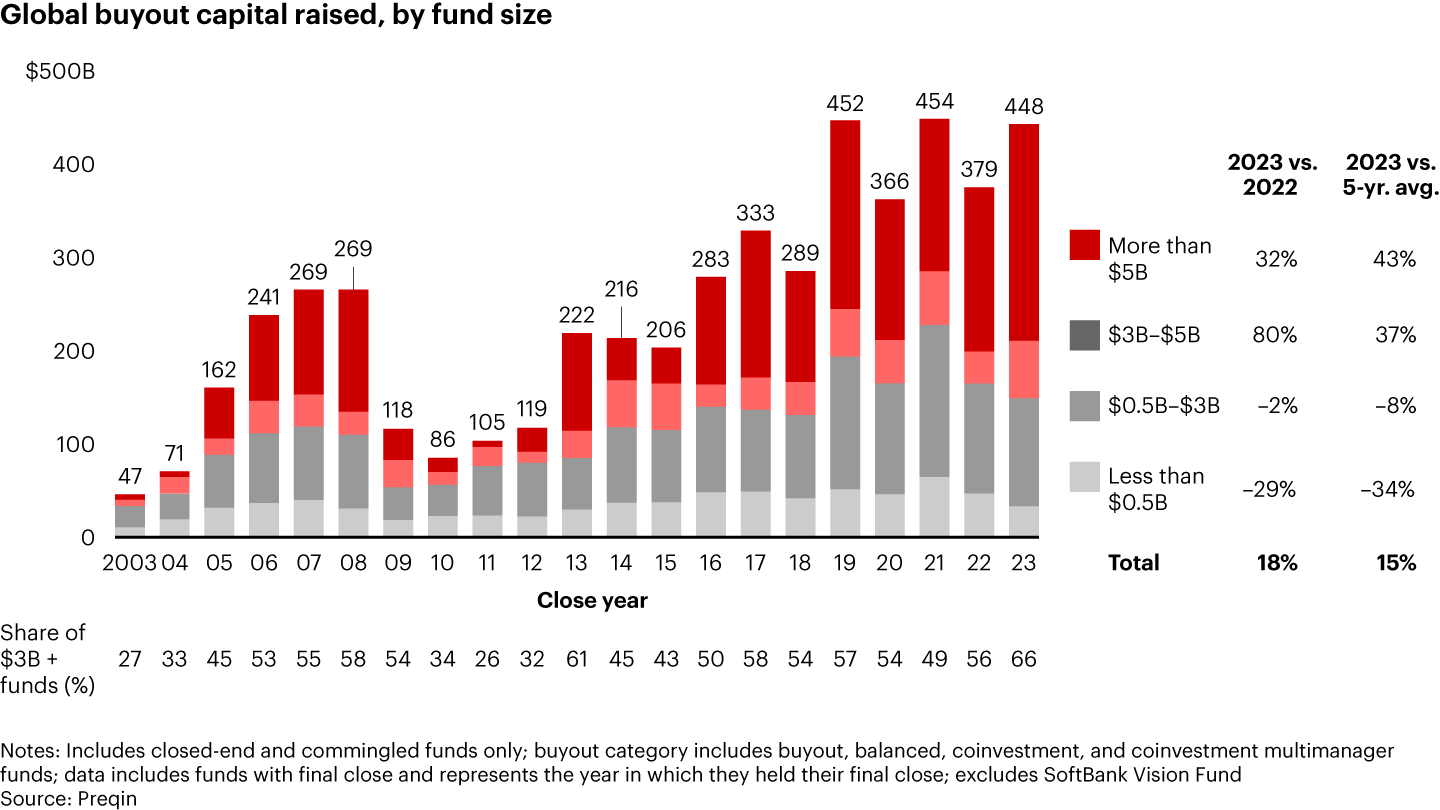
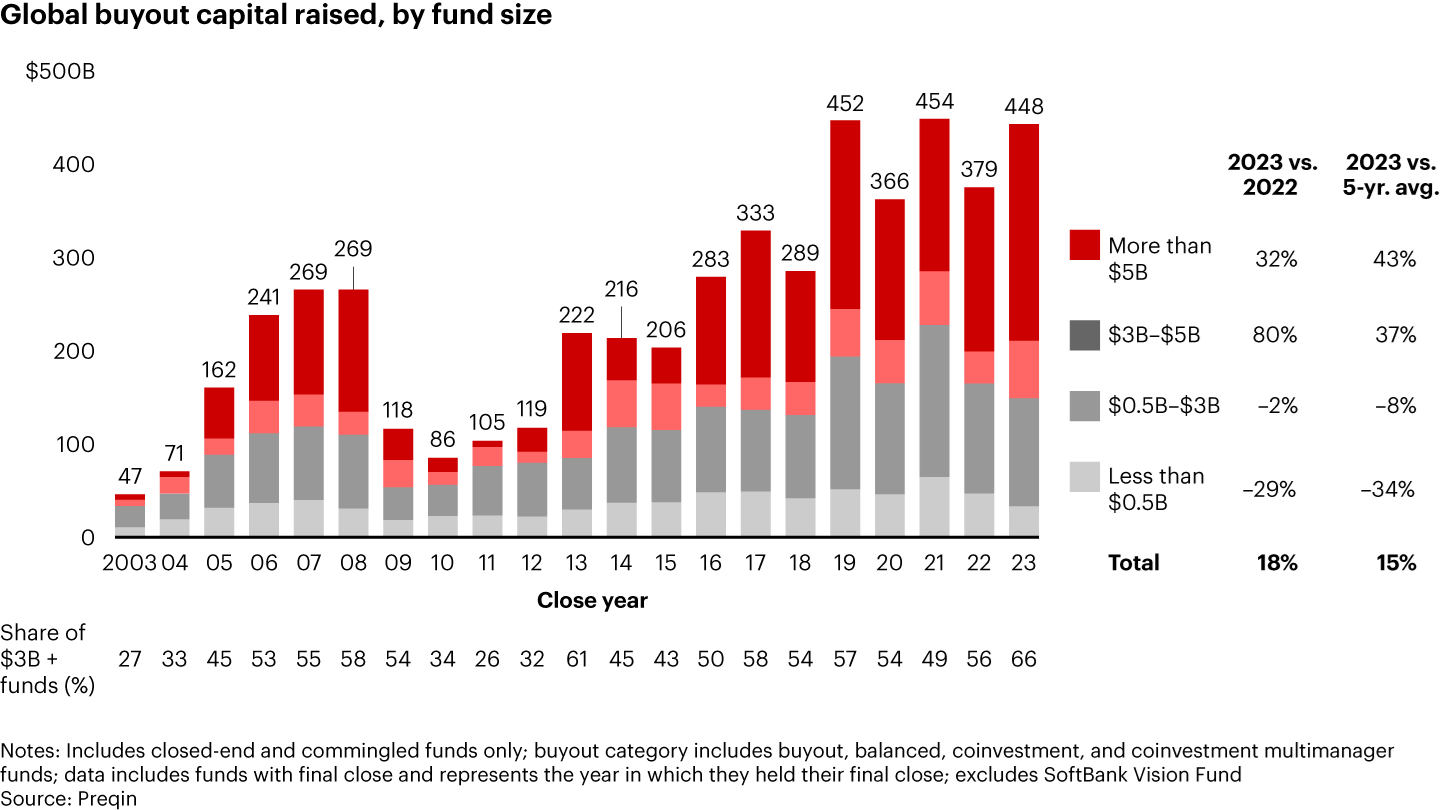
Investors’ preference for large funds obscured a sharp decline in overall fund-raising success during the year. While the average size of a buyout fund closed in 2023 was $1.2 billion—an 83% increase from 2022 and by far an industry record—the number of funds closed (449) declined 38% year over year (see Figure 20).
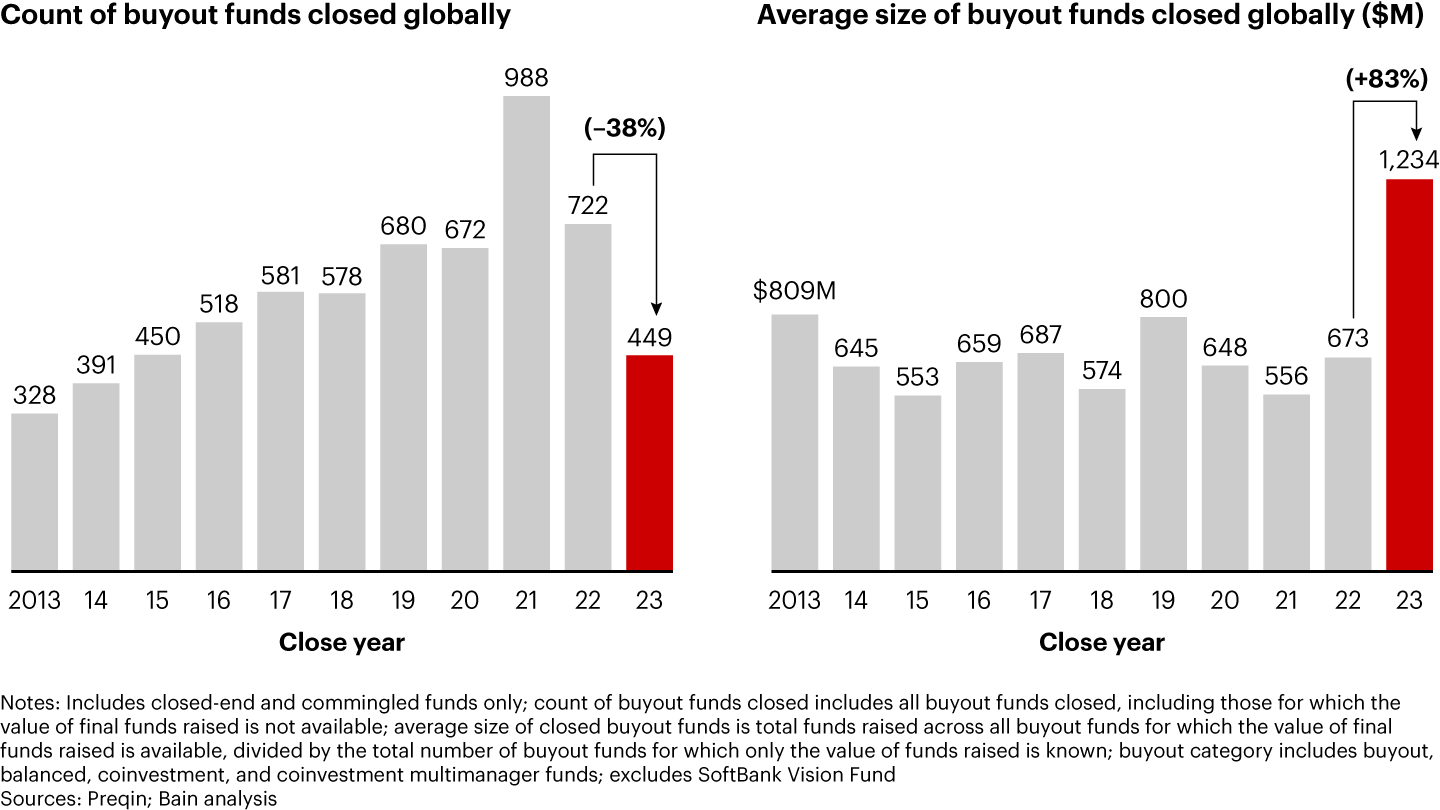

Competition for capital has never been more intense. Private capital’s breakneck growth over the past decade has led to a highly diverse industry with $14.5 trillion in assets under management (see Figure 21). Yet it’s become clear in recent years that there isn’t enough capital to go around. As of January 2024, approximately 14,500 funds across the industry were on the road seeking $3.2 trillion in capital, and only $1 closed for every $2.40 targeted, marking the worst supply/demand imbalance in more than a decade (see Figure 22).
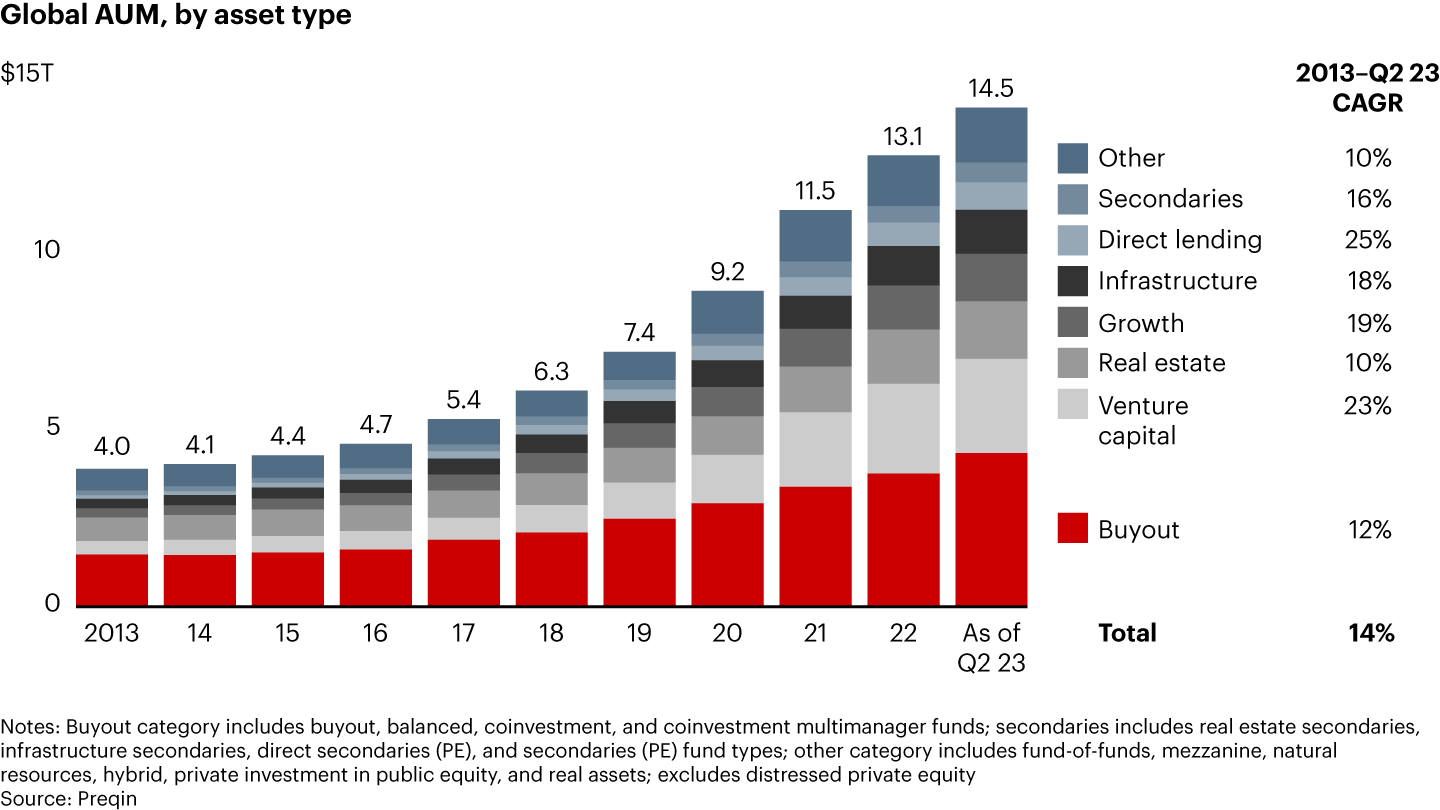
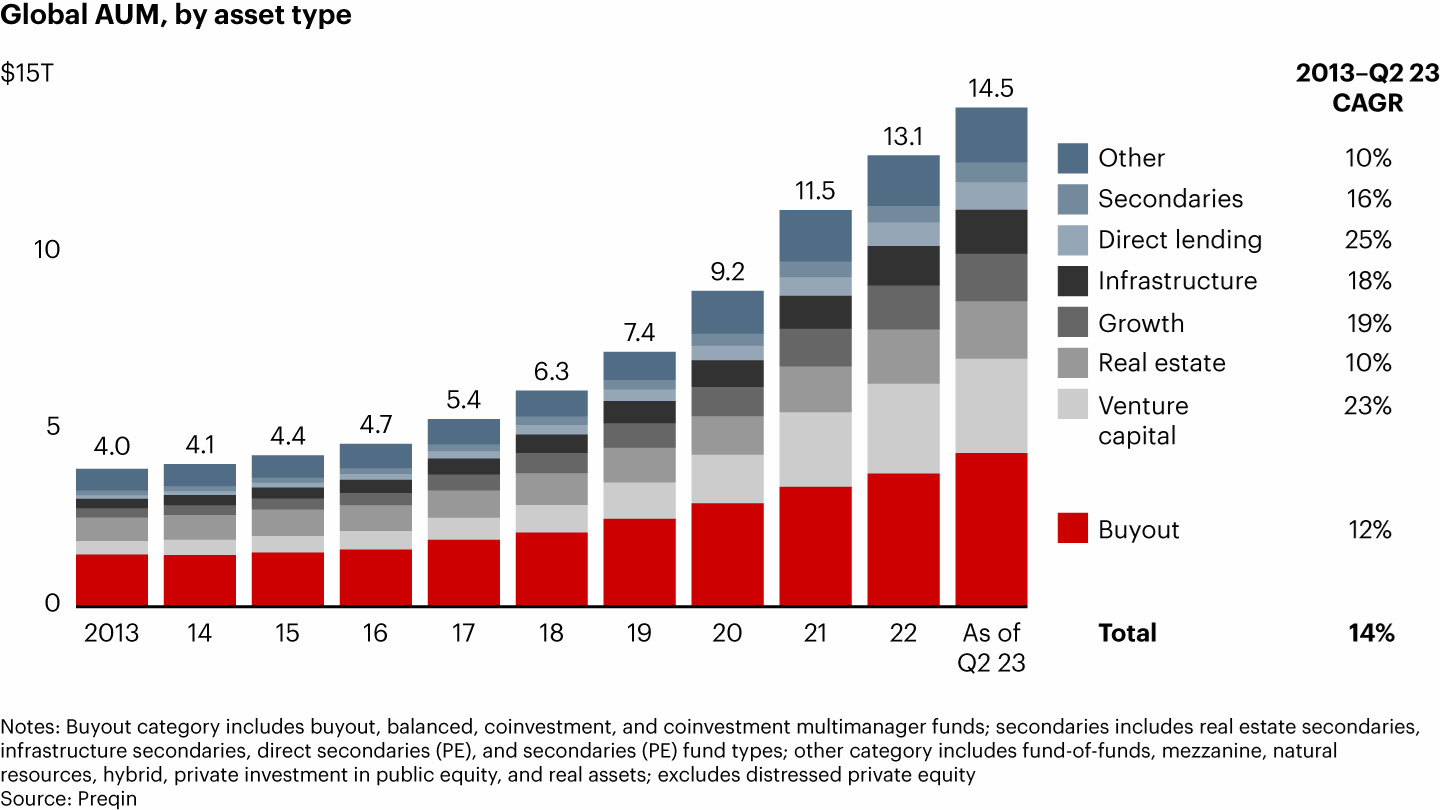
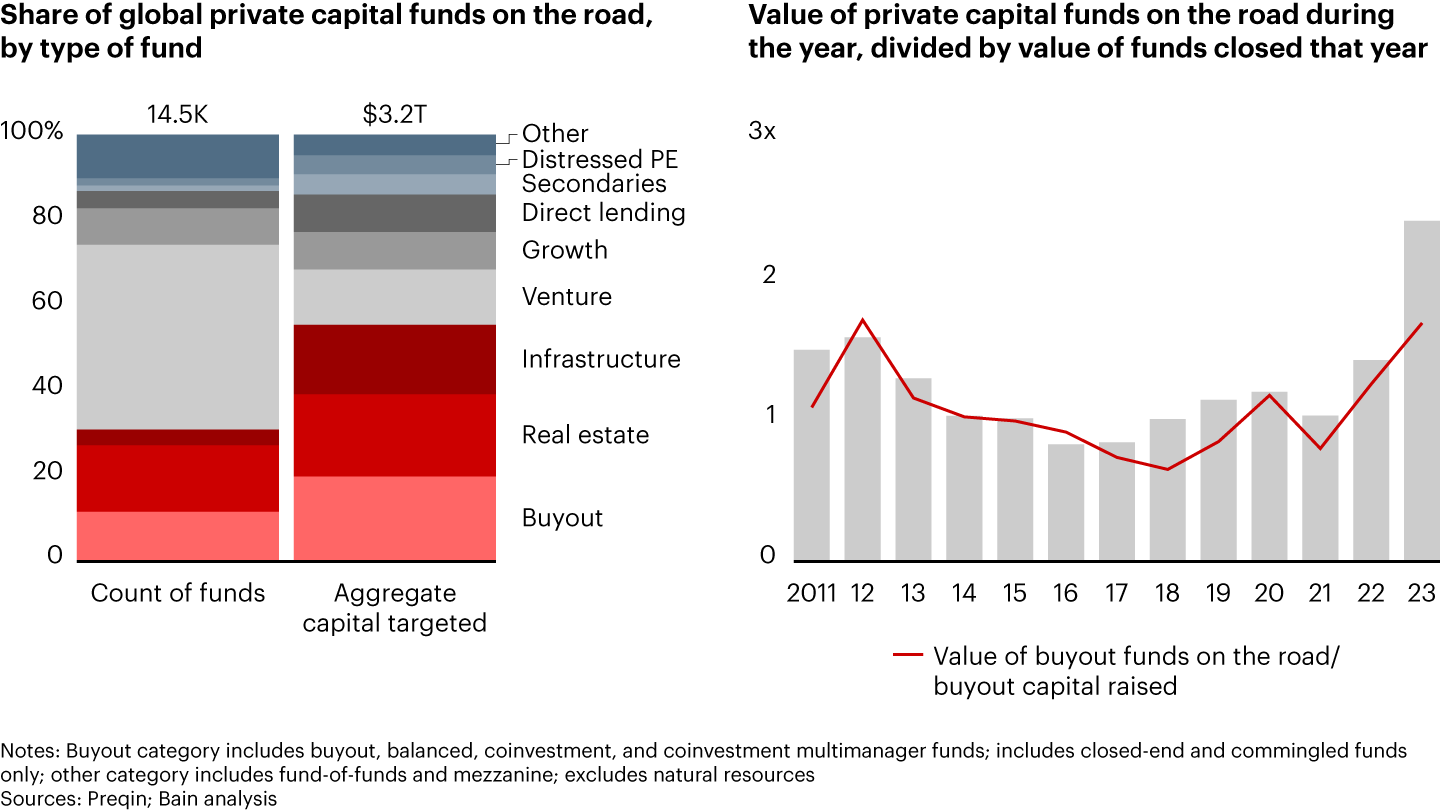

Surveys suggest that LPs remain committed to private equity, both short term and long term (see Figure 23). But as a practical matter, increasing allocations will come down to cash flows. LPs have been cash flow negative for four out of the last five years, as unexited assets began to pile up and DPI lagged (see Figure 24).
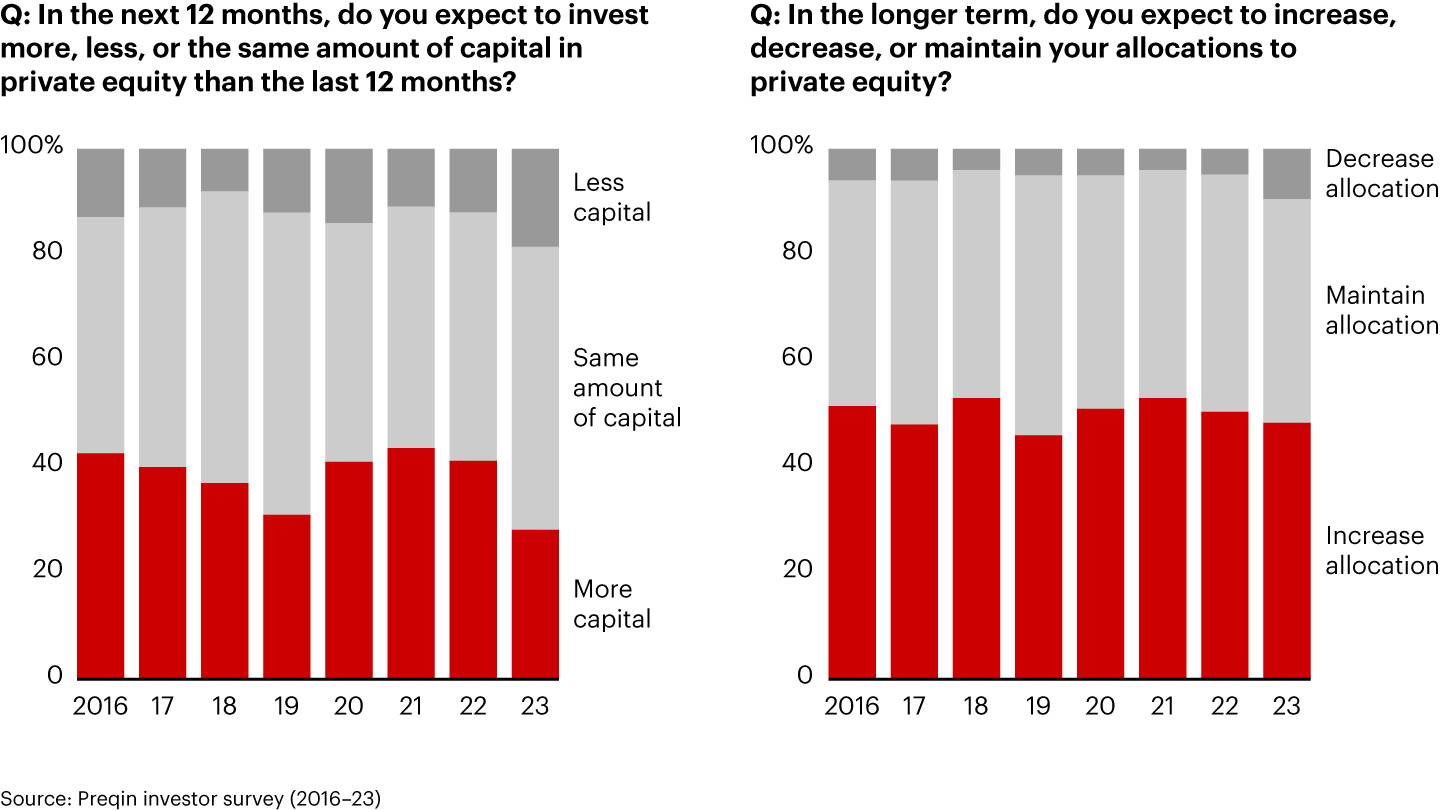

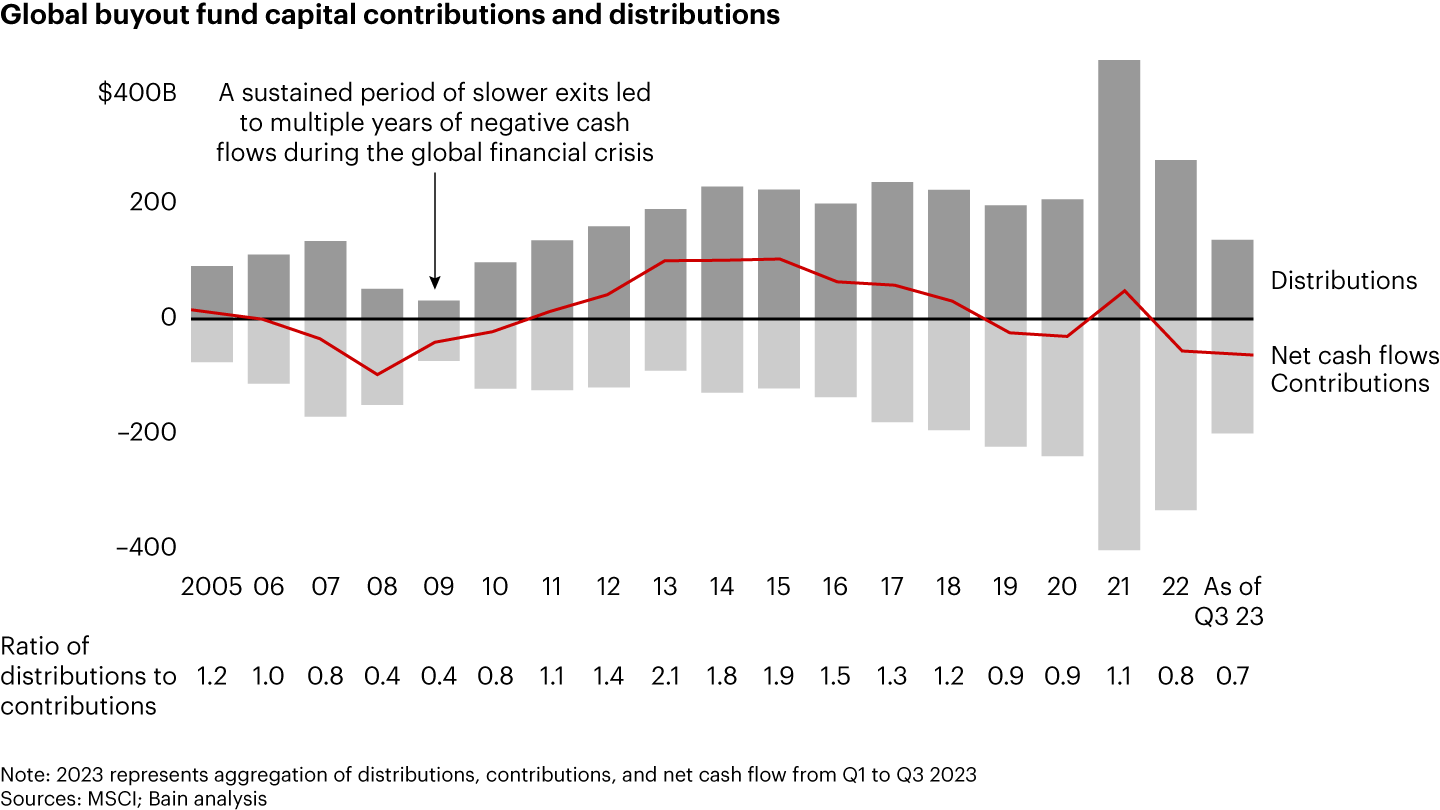
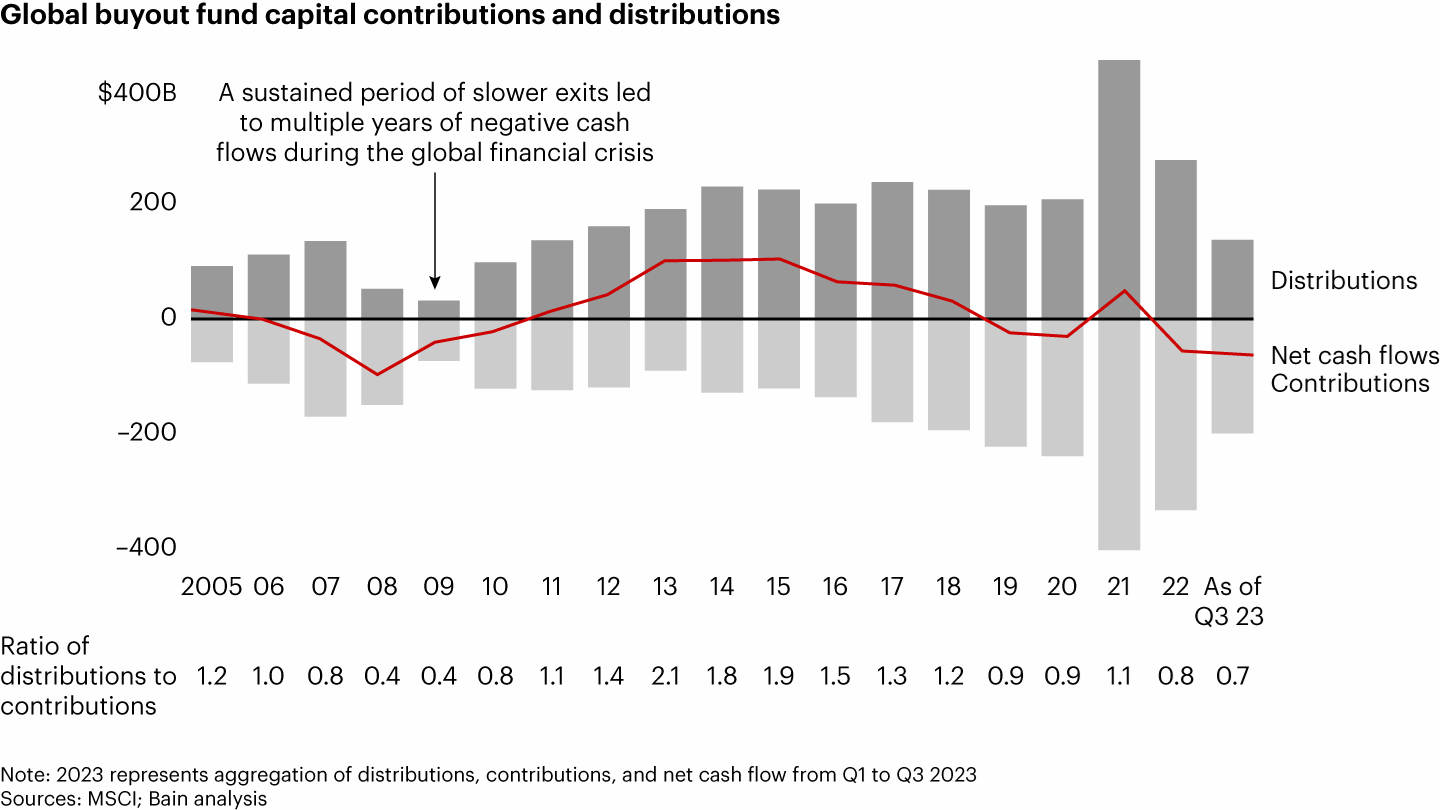
It’s also true that the pace of drawdowns from recent fund vintages has been rapid by historical standards, largely because of the post–Covid-19 boom in dealmaking. On a normalized basis (accounting for the difference in industry size), drawdowns from 2020–21 buyout fund vintages are tracking the 2006 vintage, which had the steepest pace of outflows in the industry’s history and an abnormally slow payback period amid the post-GFC recession.
As we explore later in this report, there are reasons to believe the 2020–21 vintages will eventually break with this pattern. But the concern among LPs is that, because this capital was invested at peak price multiples right before rates took off, it may be trapped for longer than is typical. Getting exit markets unstuck will likely take two things: meaningful easing by the Fed in the year ahead and efforts to justify those high multiples through the hard work of creating new value at portfolio companies.
Returns
For LPs, of course, private equity’s enduring appeal boils down to steady long-term returns and diversification. In 2023, the industry continued to shine on all counts.
The 10-year horizon internal rate of return (IRR) for buyout funds in both the US and Western Europe has trended downward slightly since 2021. But the industry still beat public-market proxies over that period and handily outperforms the more volatile public sector for time periods greater than a year (see Figures 25 and 26). And with the so-called Magnificent Seven technology stocks now accounting for 28% of the S&P 500 Index and driving its performance, private equity funds are also playing an increasingly vital role in helping LPs maintain diversification in their portfolios.
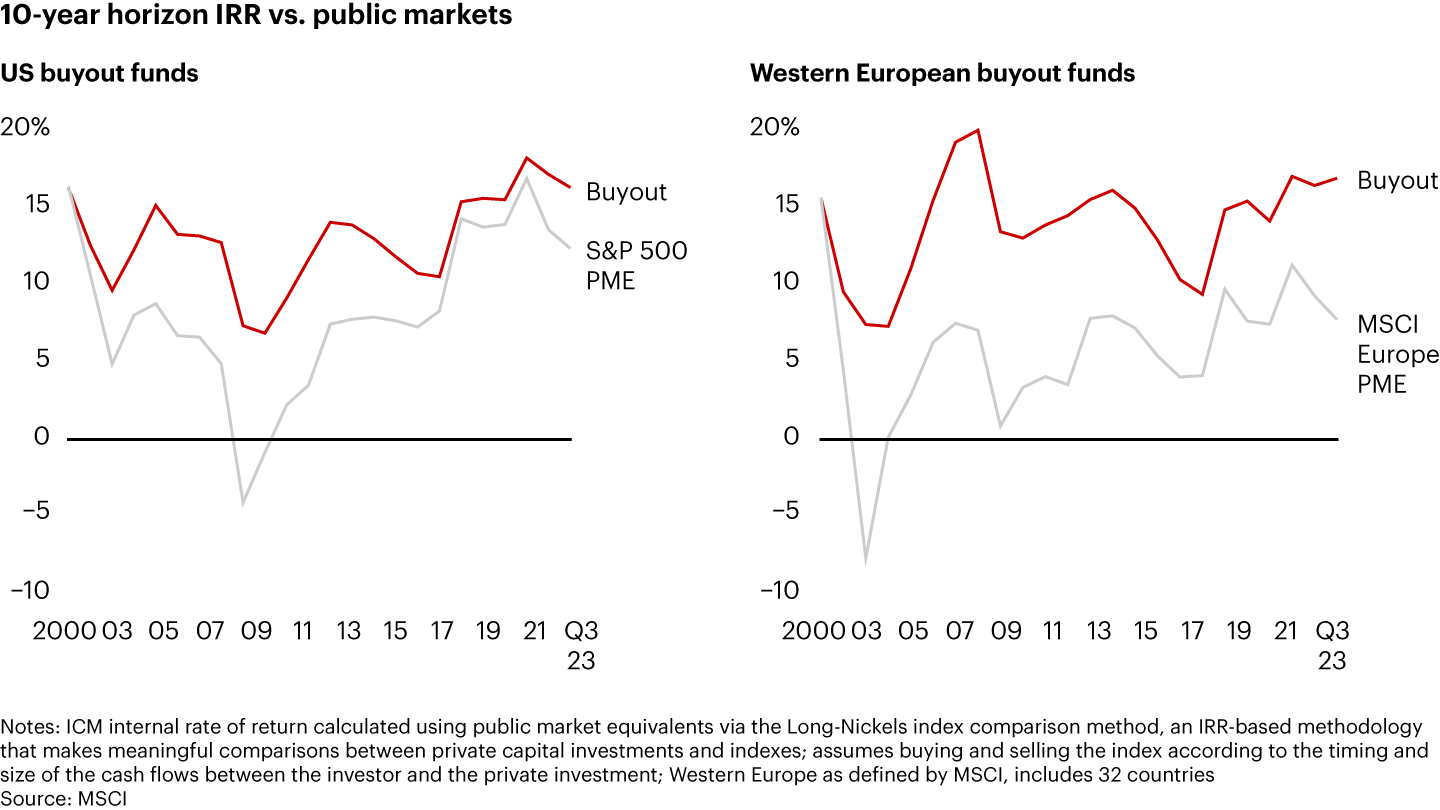

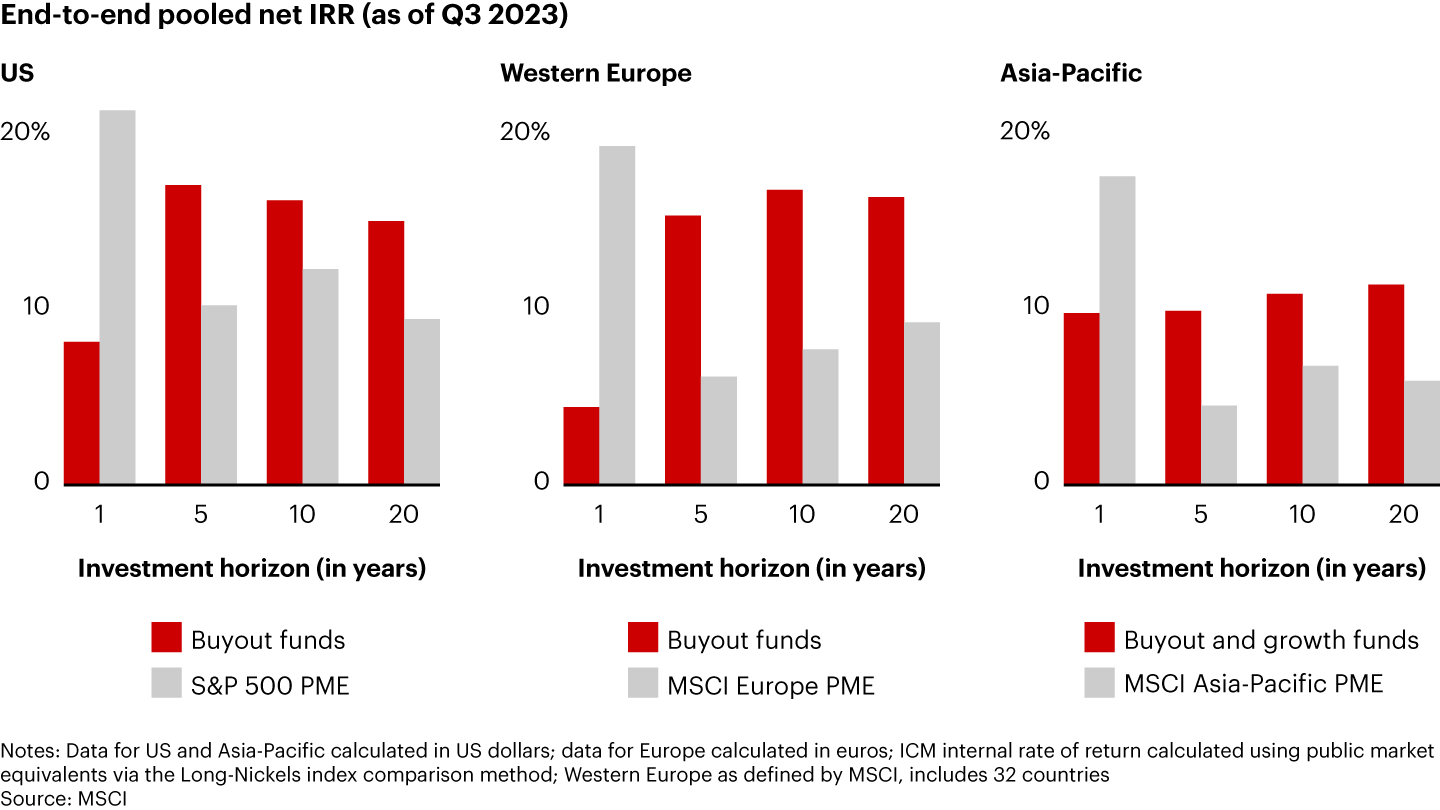

In a period of sustained high (or at least higher) interest rates, however, maintaining performance will likely call on GPs to raise their game when it comes to value creation. Buyout funds on average have essentially ignored margin growth as a driver of value over the last decade and have been carried along by multiple expansion (see Figure 27). Top-quartile deals, however, tend to have a different mix. While these industry stars have also leaned on multiple expansion for half the upward movement in the enterprise value of their portfolio companies, margin improvement plays a significantly larger role than it does for the average fund (see Figure 28).
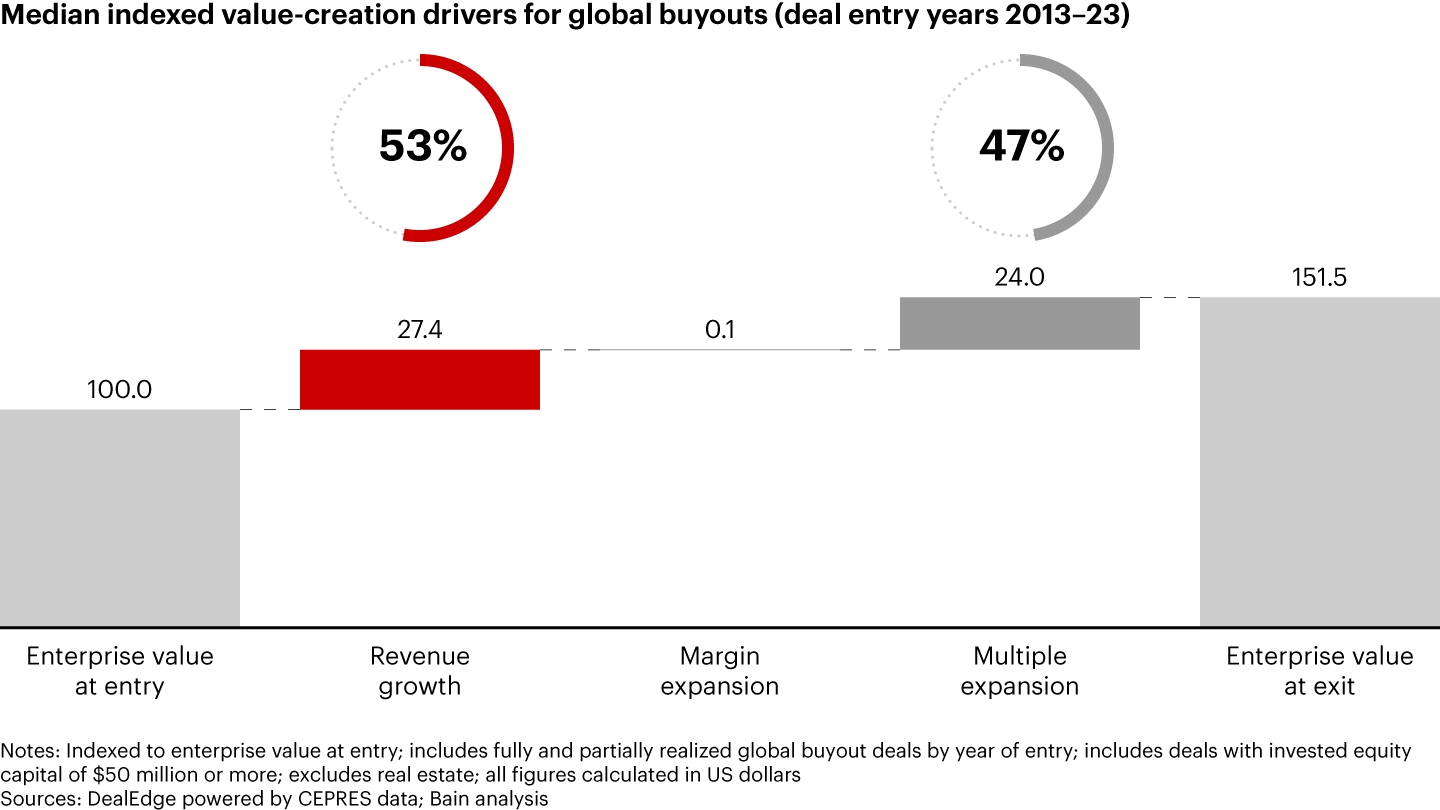
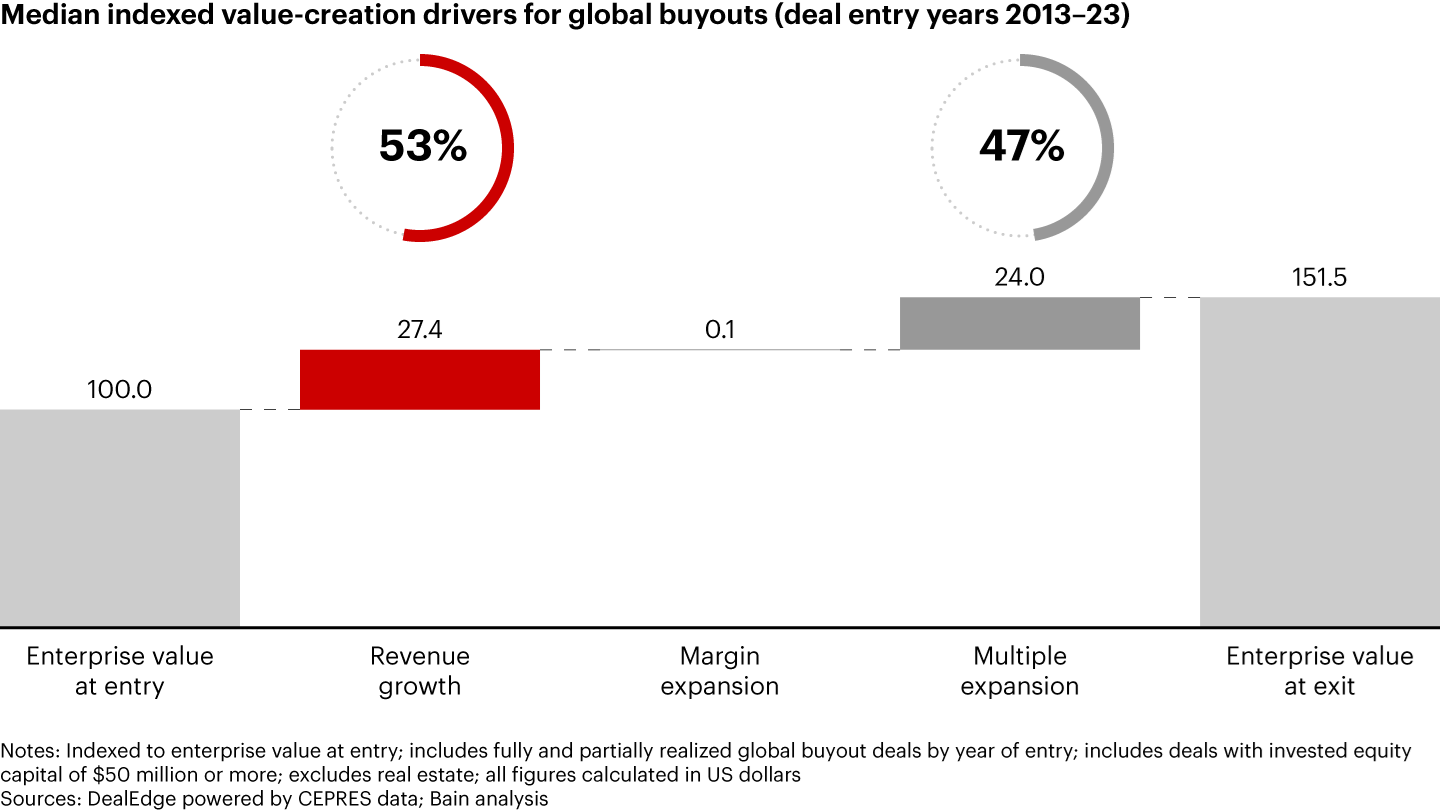
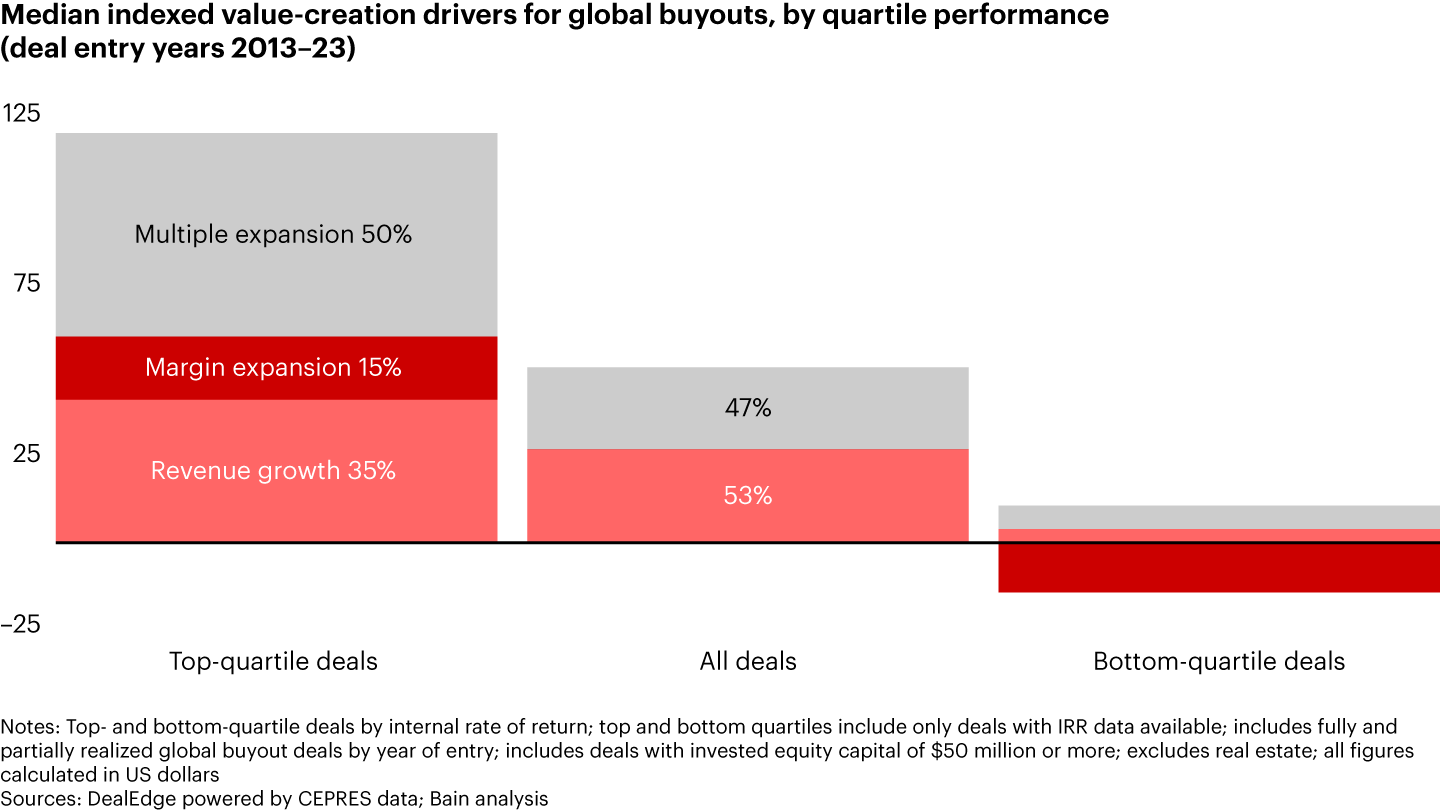
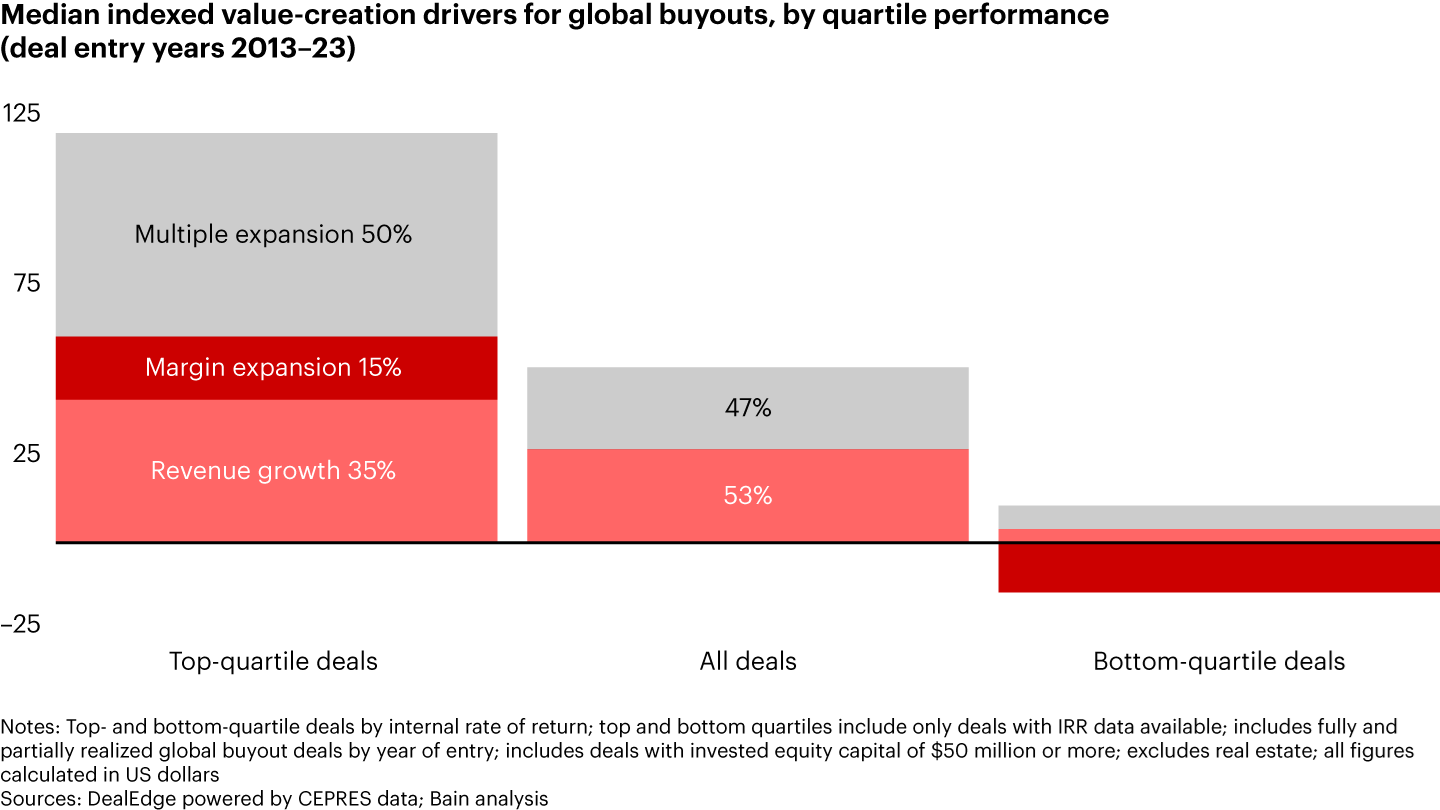
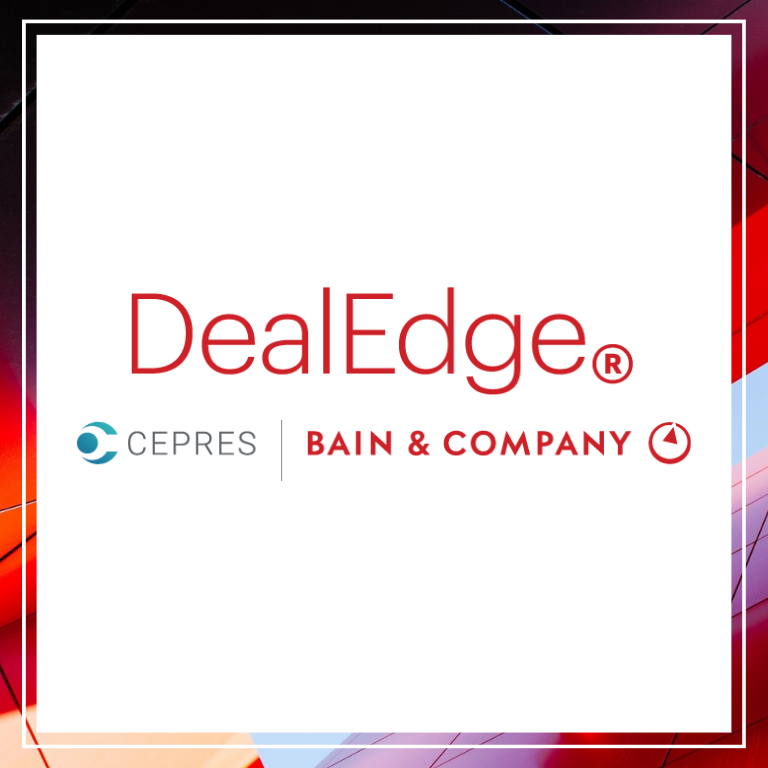
Sharpen your fund and sector strategy
DealEdge is the most granular PE analytics platform in market, covering more than 570 subsectors and offering more than 20 deal-level performance and operational metrics.
This suggests that, to drive the steady performance LPs increasingly demand, GPs will need value-creation strategies that increase operating leverage by boosting revenue and margins, not just revenue alone. This will be especially critical as higher interest rates put the brakes on the multiple expansion that the industry took for granted in the era of 0% rates. Figuring out how to generate performance without those macro tailwinds is what will separate winners and losers in 2024 and beyond.